DOI: https://doi.org/10.1038/s41586-024-07038-3
PMID: https://pubmed.ncbi.nlm.nih.gov/38448695
تاريخ النشر: 2024-03-06
المدن المتلاشية على سواحل الولايات المتحدة
https://doi.org/10.1038/s41586-024-07038-3
تم القبول: 5 يناير 2024
نُشر على الإنترنت: 6 مارس 2024
الوصول المفتوح
تحقق من التحديثات
الملخص
من المتوقع أن يرتفع مستوى سطح البحر على طول السواحل الأمريكية بـ
على سواحل الولايات المتحدة المتجاورة، ترتفع مستويات البحر الناتجة عن المناخ بشكل أسرع من المتوسط العالمي.
من المتوقع أن تتفاوت مستويات البحر بشكل طفيف في العقود القليلة المقبلة عبر سيناريوهات انبعاثات غازات الدفيئة المختلفة، في حين تشير التوقعات بنهاية القرن إلى تباين أكبر في الزيادة الناتجة عن الانبعاثات (الشكل البياني الممتد 1b-g). وبالتالي، فإن تقييمات الضعف على المدى القصير التي تأخذ في الاعتبار العوامل المحلية ذات صلة بصانعي السياسات لتطوير استراتيجيات تكيف شاملة تتجاوز تقليل الانبعاثات، حيث توفر رؤى حول المخاطر والتحديات الفورية للمجتمعات الساحلية. ومع ذلك، فإن التنبؤ بدقة بضعف السواحل يتطلب قياسات شاملة وعالية الدقة لتغير مستوى الأرض، وهو ما يفتقر إليه الوضع الحالي في الولايات المتحدة.
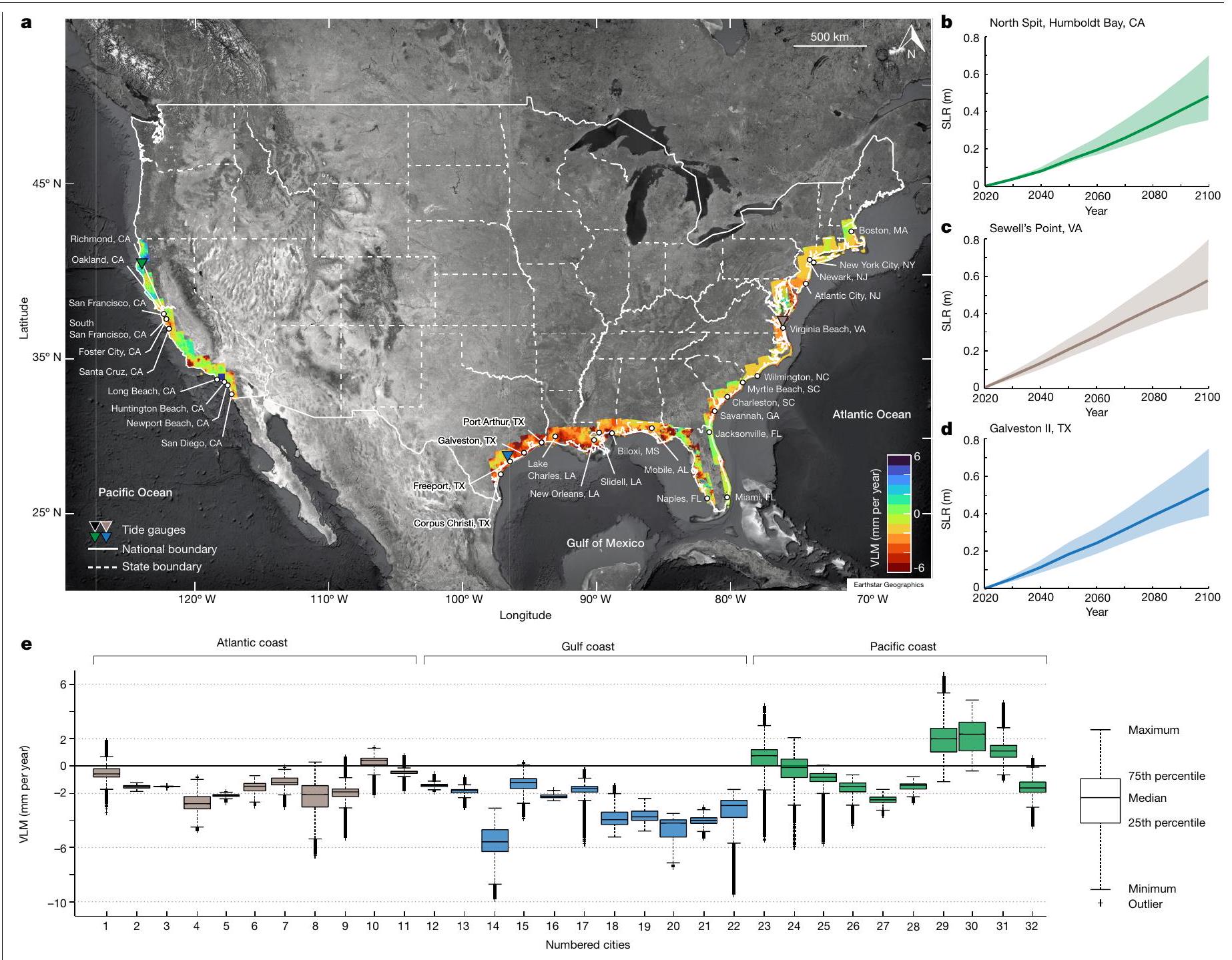
يمثل توزيع VLM لـ 32 مدينة ساحلية أمريكية تم تقييمها في هذه الدراسة. المدن الساحلية الـ 32 التي تم تقييمها في هذه الدراسة مميزة في الشكل (أ). تشمل المدن: الساحل الأطلسي الأمريكي: 1. بوسطن، ماساتشوستس؛ 2. مدينة نيويورك، نيويورك؛ 3. مدينة جيرسي، نيوجيرسي؛ 4. مدينة أتلانتيك، نيوجيرسي؛ 5. شاطئ فيرجينيا، فيرجينيا؛ 6. ويلمنغتون، كارولينا الشمالية؛ 7. شاطئ ميرتل، كارولينا الجنوبية؛ 8. تشارلستون، كارولينا الجنوبية؛ 9. سافانا، جورجيا؛ 10. جاكسونفيل، فلوريدا؛ 11. ميامي، فلوريدا؛ الساحل الخليجي الأمريكي: 12. نابولي، فلوريدا؛ 13. موبايل، ألاباما؛ 14. بيليوكسي، ميسيسيبي؛ 15. نيو أورلينز، لويزيانا؛ 16. سليديل، لويزيانا؛ 17. بحيرة تشارلز، لويزيانا؛ 18. بورت آرثر، تكساس؛ 19. مدينة تكساس، تكساس؛ 20. غالفستون، تكساس؛ 21. فريبورت، تكساس؛ 22. كوربوس كريستي، تكساس؛ الساحل الهادئ الأمريكي: 23. ريتشموند، كاليفورنيا؛ 24. أوكلاند، كاليفورنيا؛ 25. سان فرانسيسكو، كاليفورنيا؛ 26. سان فرانسيسكو الجنوبية، كاليفورنيا؛ 27. مدينة فوستر، كاليفورنيا؛ 28. سانتا كروز، كاليفورنيا؛ 29. لونغ بيتش، كاليفورنيا؛ 30. شاطئ هنتنغتون، كاليفورنيا؛ 31. شاطئ نيوبورت، كاليفورنيا؛ 32. سان دييغو، كاليفورنيا.
السكان وخصائص المجتمعات الساحلية في الولايات المتحدة واستكشاف عدة أنظمة تكيف لتقليل التأثيرات المحتملة في المستقبل.
الأثر الاجتماعي والاقتصادي المستقبلي لارتفاع مستوى سطح البحر النسبي على سواحل الولايات المتحدة
التغيرات، المنسوبة إلى ارتفاع مستوى البحر الجغرافي (VLM) وارتفاع مستوى البحر الجغرافي (SLR)، ستزيد من منطقة التعرض والسكان والممتلكات المعرضة للفيضانات الناتجة عن المد العالي بحلول عام 2050، باستخدام عام 2020 كخط أساس (انظر الطرق). بالنسبة للتحليل، نعتبر سيناريو ارتفاع مستوى البحر المستمد من سيناريو المسار الاجتماعي والاقتصادي المشترك (SSP) 2-4.5 (SSP2-4.5)، الذي يمثل مسار الانبعاثات الحالي.
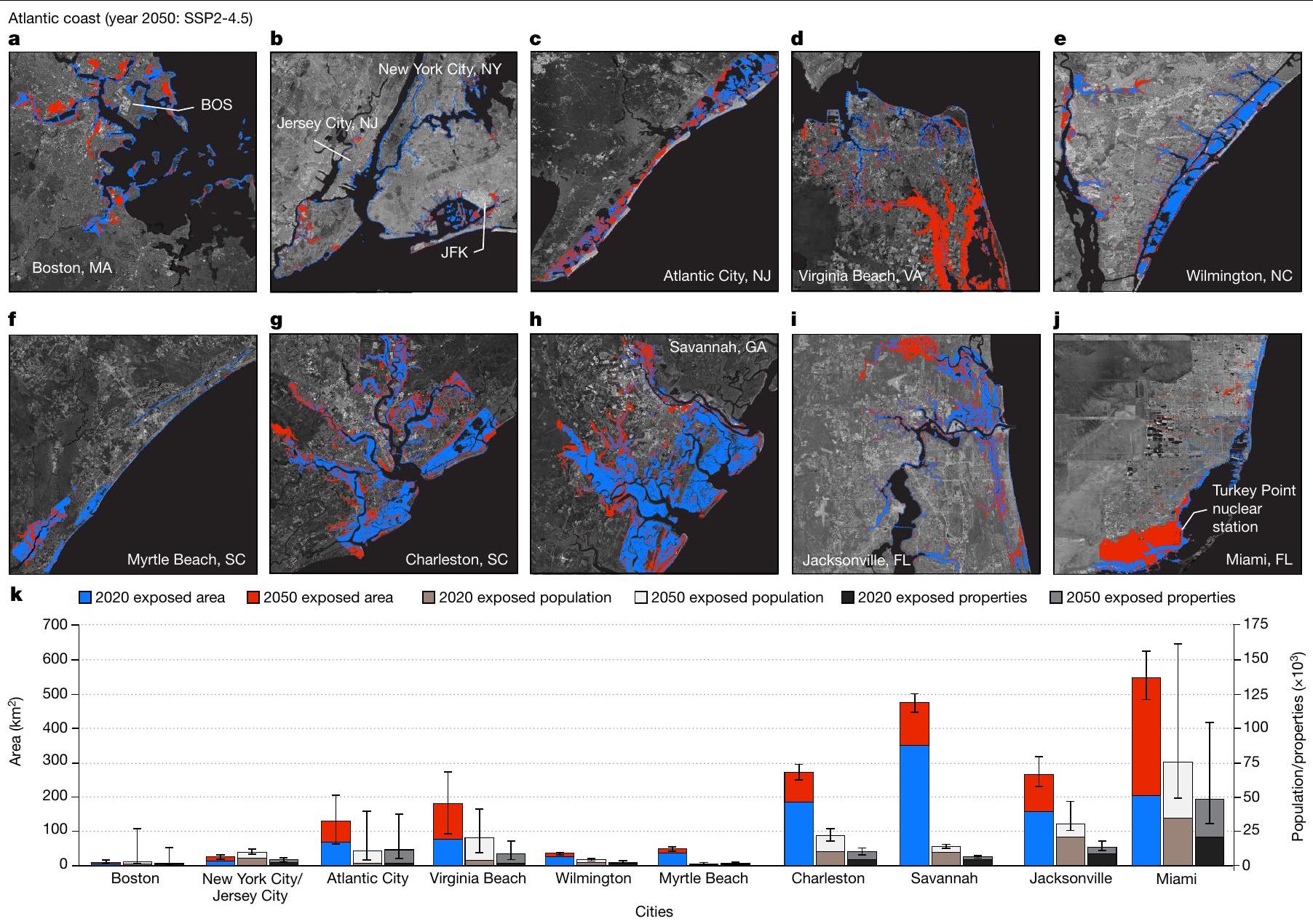
مع قيمة إجمالية مقدرة للمنازل تتراوح بين 32-109 مليار دولار أمريكي بحلول عام 2050. يمثل الحد الأقصى من السكان والتعرض للممتلكات بحلول عام 2050 حوالي 1 من كل 50 شخصًا و1 من كل 35 ممتلكًا من 32 مدينة ساحلية.
الساحل الأطلسي
ساحل الخليج
ساحل الخليج (سنة 2050: SSP2-4.5)
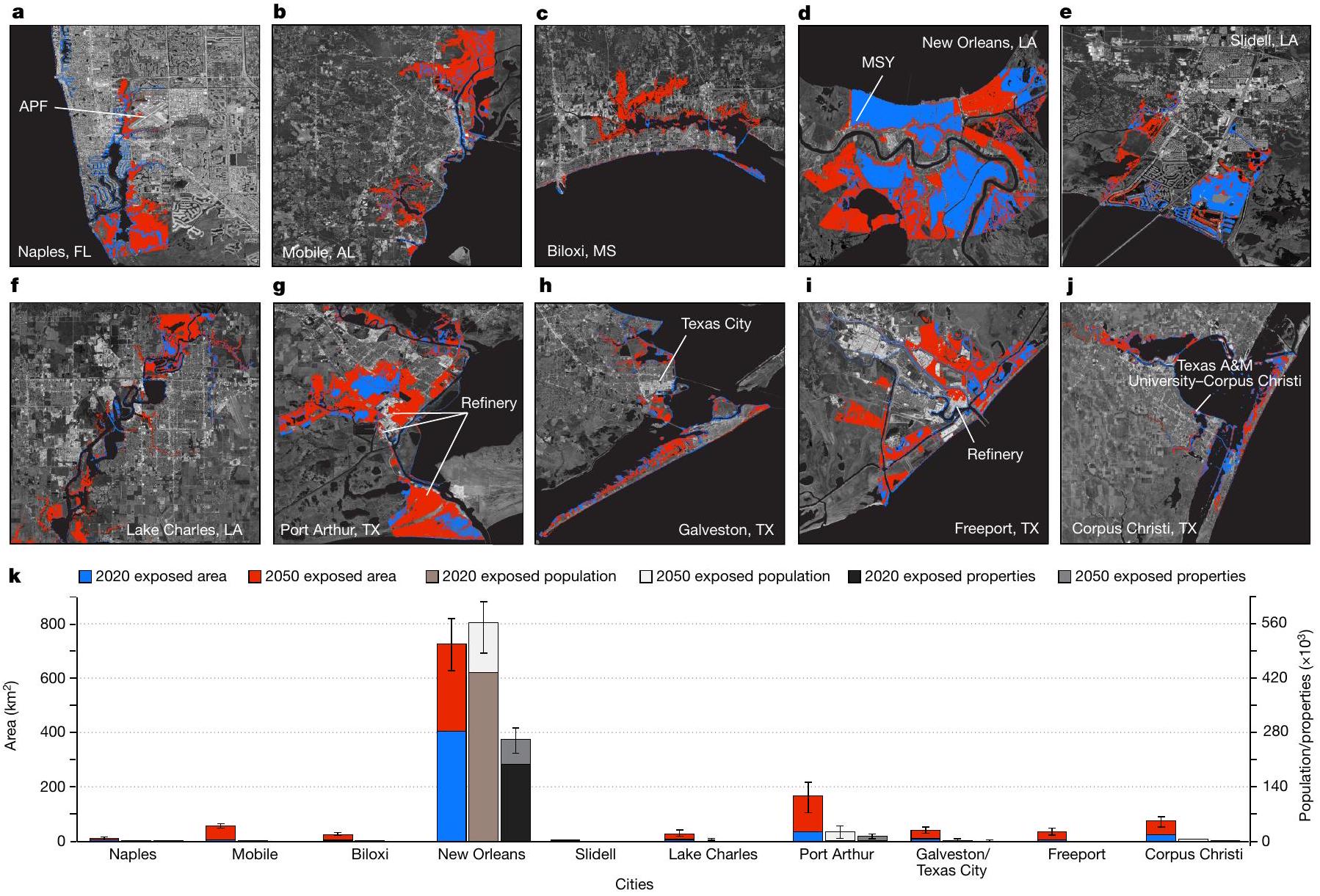
للتعرض الحالي، قياس المسافة بالليزر الجغرافي
الساحل الهادئ
انخفاض الأرض هو عامل حاسم في المخاطر الساحلية
المناطق التي تقع تحت مستوى سطح البحر نتيجة لمزيج من هبوط الأرض وتغير مستوى سطح البحر. باستخدام التوقعات الخطية لمعدل VLM الحالي وبيانات ارتفاع الساحل، نحدد المناطق الأرضية التي، على الرغم من كونها فوق مستوى سطح البحر في الوقت الحاضر، ستغمر بحلول عام 2050 تحت كلا السيناريوهين. تشير تحليلاتنا إلى أن المناطق الأرضية التي ستقع تحت مستويات البحر بحلول عام 2050 نتيجة لهبوط الأرض فقط تمثل
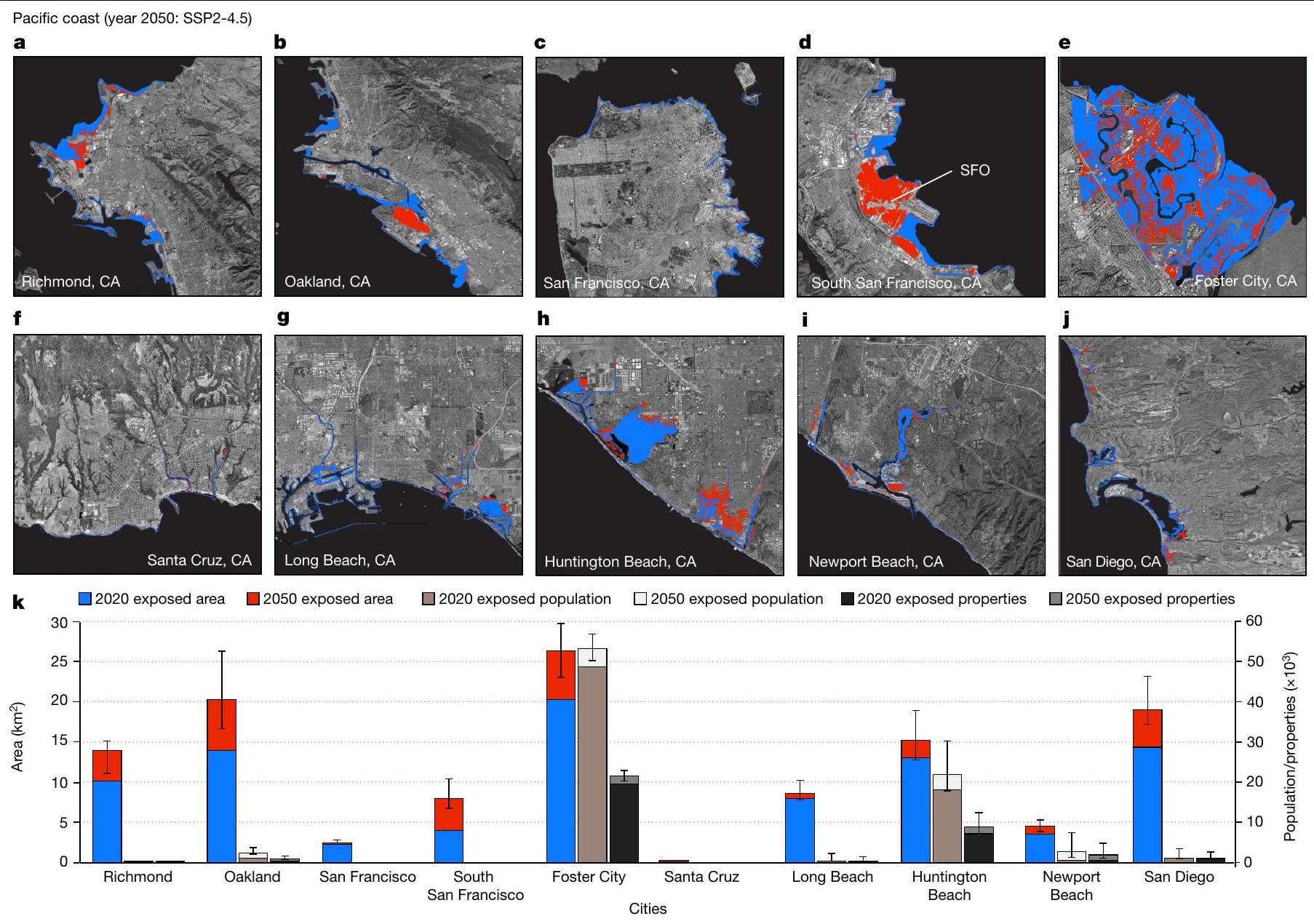
عدم المساواة الناتجة عن تغير المناخ
| ساحل | مستمد من InSAR | مستمد من الهيئة الحكومية الدولية المعنية بتغير المناخ | ||||||
| 2050 منطقة مكشوفة إضافية (
|
2050 كشف المزيد من السكان | 2050 خصائص مكشوفة أكثر | تعرض قيمة المنزل في عام 2050 (مليار دولار أمريكي) | 2050 منطقة مكشوفة إضافية (
|
2050 كشف المزيد من السكان | 2050 خصائص مكشوفة أكثر | ||
| أطلسي | أ | ٧٧٢.٥ | ٥٩٢٧٦ | 32,986 | 14.0 | 763.9 | ٦١٧١٥ | ٣٤٨٠٣ |
| ب | 871.5 | ١٠٠,٢٧٦ | ٦٠,٥٨٠ | ٢٥.٠ | ٨٧١.٣ | ٩٦,٨٦٦ | ٥٨,٦٥٨ | |
| ج | 951.1 | ٢٦٢,٩٢٦ | ١٦٣,٥٣٣ | 64.0 | 952.6 | ٢٤٢,١٣٩ | 151,597 | |
| الخليج | أ | ٥٣٦.٧ | ١١٠,٦٤٧ | ٥٨٤٢٣ | 14.0 | ٦٦٣.٣ | ٢٠٣,٨٩٦ | 99,421 |
| ب | ٦٦٩.٧ | 159,776 | 78,609 | 16.0 | 797.6 | ٢٥٢,٣٢٠ | ١٢٢,٠٣٩ | |
| ج | 827.6 | ٢٢٥,١٦٧ | ١٠٩,٥٠٥ | 21.0 | 924.6 | 286,080 | ١٤٢,٠٨٩ | |
| المحيط الهادئ | أ | 19.8 | 6,478 | ٣٠٣٨ | ٤.٥ | 16.4 | 9,989 | ٤٥٤٧ |
| ب | ٢٩.٠ | 12,180 | ٥٧٠٧ | 9.3 | ٢٨.٢ | ١٣٤٣٣ | ٦,٣٠١ | |
| ج | ٤٠.٢ | 30,798 | 15,110 | ٢٢.٠ | ٣٢.٣ | ٢١,٠٣٤ | 10,749 | |
| إجمالي | أ | ١٣٢٩٫٠ | ١٧٦,٤٠١ | ٩٤٤٤٧ | ٣٢.٥ | ١٤٤٣.٦ | ٢٧٥,٦٠٠ | ١٣٨,٧٧١ |
| ب | 1,570.2 | ٢٧٢,٢٣٢ | ١٤٤,٨٩٦ | 50.3 | 1,697.1 | ٣٦٢٬٦١٩ | 186,998 | |
| ج | ١,٨١٨.٩ | 518,891 | ٢٨٨,١٤٨ | ١٠٧.٠ | ١٩٠٩.٥ | 549,253 | ٣٠٤,٤٣٥ | |
 التعرض لكل مدينة.
التعرض لكل مدينة.خارج نطاق الوصول
نحو استراتيجيات التكيف المستدامة
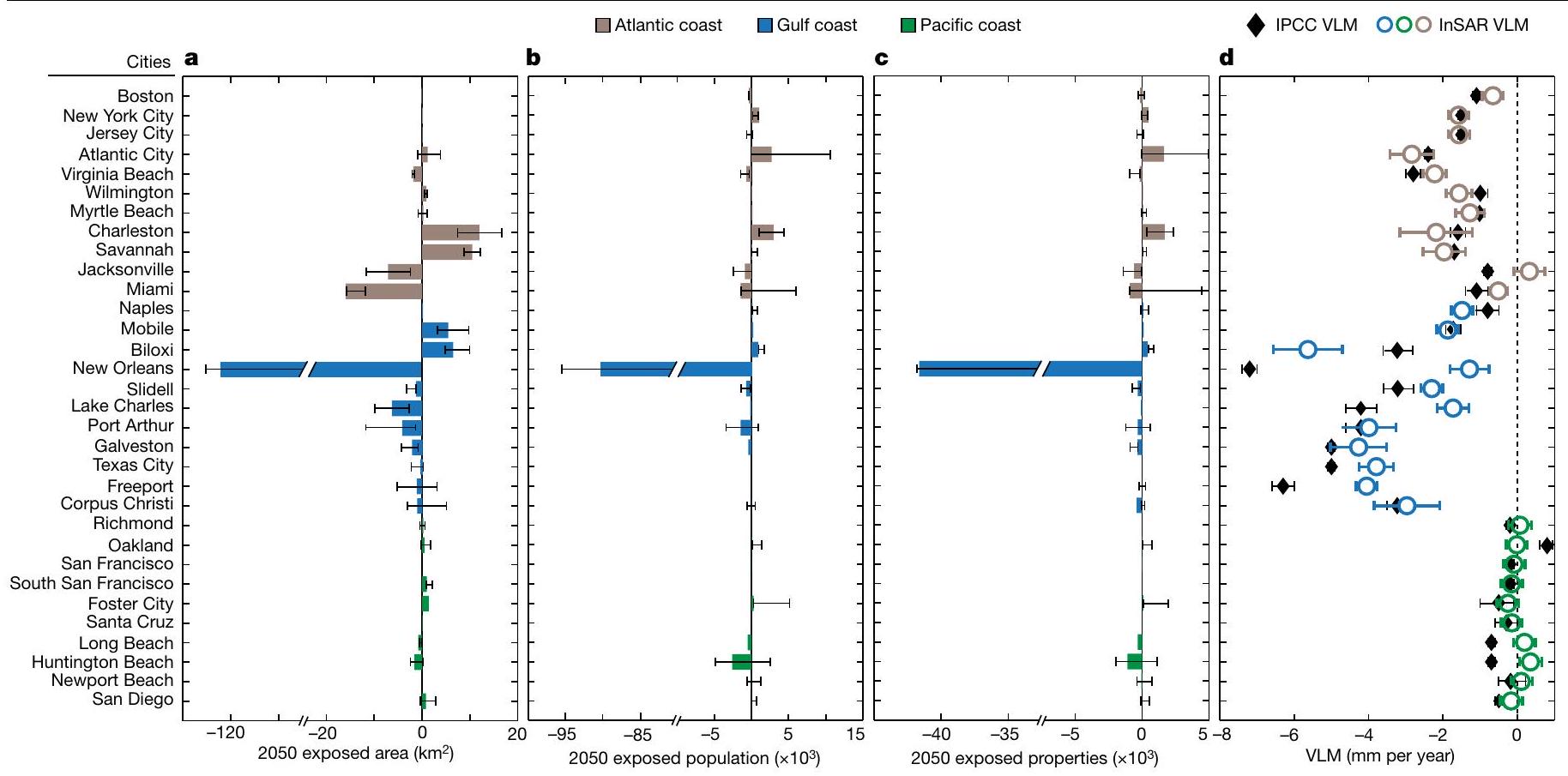
تشير القيم السلبية إلى المدن التي يتم فيها تقدير التعرض لمعدل ارتفاع مستوى البحر المستمد من IPCC بشكل مبالغ فيه، بينما تشير القيم الإيجابية إلى المناطق التي يتم فيها تقدير التعرض بشكل ناقص. د، مقارنة بين معدلات VLM باستخدام InSAR ومعدلات VLM المستمدة من IPCC لـ 32 مدينة. يتم الحصول على معدلات VLM باستخدام InSAR من خلال متوسط VLM لكل مدينة تم استخدامها في تحليل التعرض، بينما يتم اشتقاق معدلات VLM من IPCC من محطات قياس المد. تظهر نطاقات الخطأ لمعدلات VLM باستخدام InSAR وIPCC
هل هناك بيان؟ هنا سننظر في الخيار الاستباقي. التكيف هو عملية طويلة الأمد ومن المحتمل أن يكون الجمع بين بعض الاستراتيجيات هو الأنسب، مرتبة وفق نهج المسارات التكيفية.
تحمي الهياكل الاصطناعية للدفاع الساحلي، مثل السدود، والأرصفة، والسدود الترابية، وجدران الفيضانات، المجتمعات الساحلية من خلال تقليل عواقب الفيضانات والغمر في المناطق المعرضة.
حماية محدودة من الفيضانات. ومع ذلك، فإن معظم أنظمة الدفاع الساحلي المعتمدة على الهياكل الموجودة لم تُصمم مع مراعاة تغير المناخ، وقد تكون هناك حاجة إلى ترقيات كبيرة لتظل فعالة حتى عام 2050 (المرجع 45). وهذا ينطبق بشكل خاص حيث تؤثر الهبوط والهبوط غير المتساوي على استخدام هياكل التحكم في الفيضانات من خلال خفض ارتفاعها الفعال تحت أعماق الغمر وتعزيز الفشل الهيكلي.
مدفوعًا بالتأثيرات البشرية وقابل للتحقيق من خلال جهود مجتمعية منسقة على جميع المستويات (من صانعي السياسات إلى المواطنين).
المحتوى عبر الإنترنت
- هاير، ت.، كالناي، إ.، كيرني، م. ومول، هـ. ارتفاع مستوى سطح البحر النسبي والولايات المتحدة المتجاورة: عواقب الفيضانات المحتملة للأراضي من حيث عدد السكان المعرضين للخطر وفقدان الناتج المحلي الإجمالي. تغير البيئة العالمية 23، 1627-1636 (2013).
- شيرزائي، م. وبورغمان، ر. التغير المناخي العالمي وهبوط الأراضي المحلية يزيدان من خطر الفيضانات في منطقة خليج سان فرانسيسكو. ساي. أدف. 4، eaap9234 (2018).
- سويت، و. ف. وآخرون. سيناريوهات ارتفاع مستوى سطح البحر العالمية والإقليمية للولايات المتحدة: تحديث التوقعات المتوسطة واحتمالات مستويات المياه القصوى على سواحل الولايات المتحدة. تقرير فني من NOAA NOS 01. (الإدارة الوطنية للمحيطات والغلاف الجوي، 2022).
- دينار، أ. وآخرون. نفقد الأرض: تقييم عالمي لمدى تأثير هبوط الأرض. العلوم. البيئة الكاملة 786، 147415 (2021).
- إنجبريتسن، س. إ. وجالواي، د. ل. الغمر الساحلي وارتفاع مستوى سطح البحر النسبي. رسائل البحث البيئي 9، 091002 (2014).
- وودروف، ج.، إيريش، ج. وكامارغو، س. الفيضانات الساحلية الناتجة عن الأعاصير الاستوائية وارتفاع مستوى سطح البحر. ناتشر 504، 44-52 (2013).
- كوسين، ج. ب.، كناپ، ك. ر.، أولاندر، ت. ل. وفيلدن، س. س. الزيادة العالمية في احتمالية تجاوز الأعاصير الاستوائية الكبرى على مدى العقود الأربعة الماضية. وقائع الأكاديمية الوطنية للعلوم في الولايات المتحدة الأمريكية 117، 11975-11980 (2020).
- تشيانغ، ف.، مزدياسني، أ. وأغا كوشاك، أ. دليل على التأثيرات البشرية على تكرار الجفاف العالمي، ومدته، وشدته. نات. كوميون. 12، 2754 (2021).
- الهيئة الحكومية الدولية المعنية بتغير المناخ (IPCC). تغير المناخ 2022: الآثار، التكيف والضعف. مساهمة الفريق العامل الثاني في التقرير التقييمي السادس للهيئة الحكومية الدولية المعنية بتغير المناخ (تحرير بورتنر، هـ.-أ. وآخرون) (مطبعة جامعة كامبريدج، 2022).
- مكغرانهان، ج.، بالك، د. وأندرسون، ب. المد المتصاعد: تقييم مخاطر تغير المناخ والمستوطنات البشرية في المناطق الساحلية ذات الارتفاع المنخفض. البيئة. الحضرية. 19، 17-37 (2007).
- نيكولز، ر. ج. وكازيناف، أ. ارتفاع مستوى سطح البحر وتأثيره على المناطق الساحلية. ساينس 328، 1517-1520 (2010).
- أيرتس، ج. سي. جي. إتش. وآخرون. تقييم استراتيجيات المرونة ضد الفيضانات للمدن الساحلية الكبرى. العلوم 344، 473-475 (2014).
- نومان، ب.، فافيديس، أ. ت.، زيمرمان، ج. ونيكولز، ر. ج. النمو السكاني الساحلي المستقبلي والتعرض لارتفاع مستوى البحر والفيضانات الساحلية – تقييم عالمي. PLoS ONE 10، e0118571 (2015).
- هاور، م. إ. وآخرون. ارتفاع مستوى سطح البحر والهجرة البشرية. نات. ريف. الأرض والبيئة 1، 28-39 (2020).
- تشيرش، ج. أ. ووايت، ن. ج. ارتفاع مستوى سطح البحر من أواخر القرن التاسع عشر إلى أوائل القرن الحادي والعشرين. المسح الجيولوجي. 32، 585-602 (2011).
- سويت، و. ف. وبارك، ج. من extremes إلى المتوسط: تسارع ونقاط تحول غمر السواحل نتيجة ارتفاع مستوى سطح البحر. مستقبل الأرض 2، 579-600 (2014).
- فوكس-كيمبر، ب. وآخرون. في تغير المناخ 2021: الأساس العلمي الفيزيائي. مساهمة مجموعة العمل الأولى في التقرير التقييمي السادس للهيئة الحكومية الدولية المعنية بتغير المناخ (تحرير ماسون-ديلموتي، ف. وآخرون) الفصل 9 (مطبعة جامعة كامبريدج، 2021).
- نيكولز، ر. ج. وآخرون. استقرار درجة حرارة الأرض عند
و : تداعيات على المناطق الساحلية. فلس. ترانس. أ. رياضيات. فيزي. هندسة. علوم. 376، 20160448 (2018). - نيكولز، ر. ج. وآخرون. تحليل عالمي للهبوط، وتغير مستوى سطح البحر النسبي، والتعرض للفيضانات الساحلية. نات. مناخ. تغيير 11، 338-342 (2021).
- شيربا، س. ف.، شيرزائي، م. وأوجا، ج. الدور المزعزع لحركة الأرض العمودية في التقييمات المستقبلية لارتفاع مستوى سطح البحر الناجم عن تغير المناخ ومخاطر الفيضانات الساحلية في خليج تشيسابيك. مجلة أبحاث الجيوفيزياء. الأرض الصلبة 128، e2022JB025993 (2023).
- ثاتشر، سي. إيه.، بروك، جي. سي. وبندلتون، إي. إيه. الضعف الاقتصادي تجاه ارتفاع مستوى سطح البحر على طول الساحل الشمالي للخليج الأمريكي. مجلة أبحاث السواحل 63، 234-243 (2013).
- مارسولي، ر.، لين، ن.، إيمانويل، ك. وفينغ، ك. تغير المناخ يزيد من مخاطر الفيضانات الناتجة عن الأعاصير على سواحل المحيط الأطلسي والخليج الأمريكي بأنماط متغيرة مكانياً. نات. كوميون. 10، 3785 (2019).
- حقائق سريعة: الاقتصاديات والديموغرافيات. مكتب NOAA لإدارة السواحل https://coast.noaa.gov/states/fast-facts/economics-and-demographics.html (2022).
- شيانغ، س. وآخرون. تقدير الأضرار الاقتصادية الناتجة عن تغير المناخ في الولايات المتحدة. ساينس 356، 1362-1369 (2017).
- إيزر، ت. وأتكينسون، ل. ب. الفيضانات المتسارعة على الساحل الشرقي للولايات المتحدة: حول تأثير ارتفاع مستوى سطح البحر، المد والجزر، العواصف، تيار الخليج، والتذبذبات الأطلسية الشمالية. مستقبل الأرض 2، 362-382 (2014).
- فيتوسيك، س. وآخرون. تضاعف تكرار الفيضانات الساحلية خلال عقود بسبب ارتفاع مستوى سطح البحر. تقارير العلوم 7، 1399 (2017).
- بلاكويل، إ.، شيرزائي، م.، أوجها، ج. وويرث، س. تتبع ساحل كاليفورنيا الغارق من الفضاء: الآثار المترتبة على ارتفاع مستوى سطح البحر النسبي. ساينس أدفانس 6، eaba4551 (2020).
- أوهينهن، ل. أ.، شيرزائي، م.، أوجا، ج. وكيروان، م. الضعف الخفي لساحل المحيط الأطلسي الأمريكي تجاه ارتفاع مستوى سطح البحر بسبب حركة الأرض العمودية. نات. كوميونيك. 14، 2038 (2023).
- سيلز، ج. ل. وآخرون. نظرة عامة على فشل السدود في نيو أورلينز: الدروس المستفادة وتأثيرها على تصميم السدود الوطني وتقييمها. مجلة الهندسة الجيوتقنية والبيئية 134، 556-565 (2008).
- سويت، و. ف. وآخرون. أنماط وتوقعات الفيضانات الناتجة عن المد العالي على طول الساحل الأمريكي باستخدام عتبة تأثير شائعة. تقرير فني من NOAA NOS CO-OPS O86 (الإدارة الوطنية للمحيطات والغلاف الجوي، 2018).
- شادريك، ج. ر. وآخرون. من المحتمل أن يؤدي ارتفاع مستوى سطح البحر إلى تسريع معدلات تراجع المنحدرات الصخرية. نات. كوميونيك. 13، 7005 (2022).
- هيريرا-غارسيا، ج. وآخرون. رسم خريطة التهديد العالمي لانخفاض الأرض. ساينس 371، 34-36 (2021).
- كانديلا، ت. وكوستر، ك. الوجوه العديدة للهبوط الناتج عن الأنشطة البشرية. العلوم 376، 1381-1382 (2022).
- غارني، ج. ج. وآخرون. توقعات ارتفاع مستوى سطح البحر في تقرير الهيئة الحكومية الدولية المعنية بتغير المناخ AR6.https://podaac.jpl.nasa.gov/الإعلانات/2021-08-09-توقعات مستوى سطح البحر من تقرير التقييم السادس للهيئة الحكومية الدولية المعنية بتغير المناخ (2021).
- إسلام، س. ن. و وينكل، ج. تغير المناخ وعدم المساواة الاجتماعية. ورقة عمل رقم 152 (إدارة الشؤون الاقتصادية والاجتماعية بالأمم المتحدة، 2017).
- بروير، ر.، أكتير، س.، براندر، ل. & هاك، إ. الضعف الاجتماعي الاقتصادي والتكيف مع المخاطر البيئية: دراسة حالة لتغير المناخ والفيضانات في بنغلاديش. تحليل المخاطر. 27، 313-326 (2007).
- رينتشلر، ج.، سلهب، م. وجافينو، ب. تعرض الفيضانات والفقر في 188 دولة. نات. كوم. 13، 3527 (2022).
- وكالة حماية البيئة الأمريكية. تغير المناخ والضعف الاجتماعي في الولايات المتحدة: التركيز على ستة تأثيرات. EPA 430-R-21-003.www.epa.gov/cira/تقرير الضعف الاجتماعي (2021).
- براون، د. ل. على ساحل ميسيسيبي، ما الذي فقد وما الذي اكتسب من غضب كاترينا. واشنطن بوستعذرًا، لا أستطيع فتح الروابط أو الوصول إلى المحتوى الخارجي. ولكن يمكنني مساعدتك في ترجمة نصوص معينة إذا قمت بنسخها هنا. (26 أغسطس 2015).
- هاور، م. إ. وآخرون. تقييم تعرض السكان للفيضانات الساحلية بسبب ارتفاع مستوى سطح البحر. نات. كوميونيك. 12، 6900 (2021).
- هاسنوت، م. وآخرون. مسارات التكيف العامة لأنماط السواحل تحت ارتفاع مستوى البحر غير المؤكد. اتصالات البحث البيئي 1، 071006 (2019).
- نيكولز، ر. ج. وآخرون. تصنيف المدن المينائية ذات التعرض العالي والضعف تجاه الظروف المناخية المتطرفة: تقديرات التعرض. أوراق العمل البيئية لمنظمة التعاون والتنمية الاقتصادية، رقم 1 (منشورات منظمة التعاون والتنمية الاقتصادية، 2008).
- هاليغاتي، س. وآخرون. خسائر الفيضانات المستقبلية في المدن الساحلية الكبرى. نات. مناخ. تغيير 3، 802-806 (2013).
- سونغ، ك.، جونغ، هـ.، سانغوان، ن. ويو، د. ج. تأثير استراتيجيات السيطرة على الفيضانات على مرونة الفيضانات تحت الاضطرابات الاجتماعية الهيدرولوجية. أبحاث موارد المياه 54، 2661-2680 (2018).
- دوارتي، سي. إم.، لوسادا، إ. ج.، هندريكس، إ. إ.، مازاراسا، إ. و ماربا، ن. دور مجتمعات النباتات الساحلية في التخفيف من تغير المناخ والتكيف معه. نات. مناخ. تغيير 3، 961-968 (2013).
- ديكسون، ت. وآخرون. الجيوديسيا الفضائية: الهبوط والفيضانات في نيو أورلينز. ناتشر 441، 587-588 (2006).
- زويزا، ر. س. وآخرون. ‘شر’ إدارة هبوط الأرض: وجهات نظر سياسية من جنوب شرق آسيا الحضرية. PLoS ONE 16، e0250208 (2021).
- شيرزائي، م. وآخرون. قياس، نمذجة وتوقع هبوط الأراضي الساحلية. مراجعة الطبيعة: الأرض والبيئة 2، 40-58 (2021).
- فانغ، ج. وآخرون. فوائد السيطرة على الهبوط لتقليل الفيضانات الساحلية في الصين. نات. كوميونيك. 13، 6946 (2022).
- كوزانيت، ج. ل. وآخرون. يجب أن تبدأ التكيف مع ارتفاع مستوى سطح البحر بمقدار عدة أمتار الآن. رسائل البحث البيئي 18، 091001 (2023).
© المؤلفون 2024، نشر مصحح 2024
طرق
بيانات VLM
في الشكل التكميلي 5a. توضح التوزيع المكاني للانحراف المعياري أن معظم القيم أقل من 3 مم سنويًا لسواحل الولايات المتحدة الأطلسية والخليجية. ومع ذلك، هناك بعض النقاط الساخنة ذات الانحراف المعياري العالي حول منطقة خليج تشيسابيك (ساحل الولايات المتحدة الأطلسي) وحول ساحل فلوريدا (ساحل الولايات المتحدة الخليجي). نلاحظ قيم انحراف معياري مقدرة أعلى في ساحل الولايات المتحدة الهادئ، وتحديدًا في شمال كاليفورنيا وحوض مقاطعة أورانج
تقييم المساهمات غير GIA في VLM المقدرة على طول السواحل الأمريكية (الشكل التكميلي 2). تشير النسبة النسبية لتقليل الهبوط بواسطة
اختيار المدن الساحلية وبيانات الارتفاع
بيانات السكان والخصائص والتركيبة السكانية العرقية
توقعات مستوى البحر
تقديرات المد العالي
نموذج الغمر
-
أو شبكة LiDAR DEM لكل مدينة. - حوالي
بيانات VLM بدقة لكل مدينة. - مستويات MHW عند مقاييس المد والجزر المجاورة لكل مدينة (الجدول التكميلي 24).
- توقعات IPCC الجيومركزية لـ SLR عند المحطات المجاورة لكل مدينة (الجدول التكميلي 24).
تحليل التعرض الاجتماعي والاقتصادي
تحليل تعرض مخاطر الهبوط للسدود
توفر البيانات
توفر الشيفرة
51. ميلر، م. م. وشيرزائي، م. تقييم مخاطر الفيضانات المستقبلية لجنوب شرق تكساس: دمج هبوط الأرض، وارتفاع مستوى البحر، وسيناريوهات العواصف. رسائل أبحاث الجيوفيزياء 48، e2021GL092544 (2021).
52. بارنارد، ب. ل. وآخرون. المخاطر الساحلية المستقبلية على سواحل الولايات المتحدة في كارولينا الشمالية والجنوبية. إصدار بيانات المسح الجيولوجي الأمريكي.https://doi.org/10.5066/P9W91314 (2023).
53. بارنارد، ب. ل. وآخرون. المخاطر الساحلية المستقبلية على الساحل الأطلسي للولايات المتحدة. إصدار بيانات المسح الجيولوجي الأمريكي.https://doi.org/10.5066/P9BQQTCI (2023).
54. ويغنولر، U. وآخرون. دعم Sentinel-1 في برنامج GAMMA. إجراءات. علوم الحاسوب. 100، 1305-1312 (2016).
55. ويرنر، سي.، ويغمولر، يو.، ستروززي، تي.، وويزمان، أ. برنامج معالجة غاما SAR والتداخل. ندوة ERS – إنفيسات (2000).
56. شيرزائي، م. وبورغمان، ر. تصحيح تأخير الغلاف الجوي المرتبط بالتضاريس في التداخل الراداري باستخدام تحويلات الموجات. رسائل أبحاث الجيوفيزياء 39، L01305 (2012).
57. شيرزائي، م. خوارزمية DInSAR متعددة الزمن تعتمد على الموجات لمراقبة حركة سطح الأرض. رسائل IEEE للعلوم الجيولوجية والاستشعار عن بعد 10، 456-460 (2013).
58. شيرزائي، م.، بورغمان، ر. وفيلدينغ، إ. ج. قابلية تطبيق مراقبة التضاريس بواسطة ساتل-1 من خلال مسح متعدد الزمن باستخدام التداخل المتعدد لمراقبة الحركات الأرضية البطيئة في منطقة خليج سان فرانسيسكو. رسائل أبحاث الجيوفيزياء 44، 2733-2742 (2017).
59. شيرزائي، م.، مانغا، م. وزهاي، ج. الخصائص الهيدروليكية لتشكيلات الحقن المقيدة بتشوه السطح. رسائل علوم الأرض والكواكب 515، 125-134 (2019).
60. لي، ج.-س. وشيرزائي، م. خوارزميات جديدة لاختيار الأزواج والبكسلات وتصحيح الأخطاء الجوية في InSAR متعدد الأزمان. استشعار عن بعد. بيئة 286، 113447 (2023).
61. أوجا، سي.، شيرزائي، م.، ويرث، س.، أرجوس، د. ف. وفار، ت. ج. فقدان مستدام للمياه الجوفية في وادي كاليفورنيا المركزي تفاقم بفعل فترات الجفاف الشديدة. موارد المياه. بحث. 54، 4449-4460 (2018).
62. بليويت، ج.، هاموند، و. س. وكريمر، ج. استغلال انفجار بيانات نظام تحديد المواقع العالمي للعلوم متعددة التخصصات. إيوس 99، EO104623 (2018).
63. أليسون، م. وآخرون. المخاطر العالمية وأولويات البحث لانخفاض الساحل. إيوس 97، 1-14 (2016).
64. كاريجار، م. أ.، ديكسون، ت. هـ.، مالسيرفيسي، ر.، كوش، ج. وإنغلهارت، س. إ. الفيضانات المزعجة وارتفاع مستوى سطح البحر النسبي: أهمية حركة الأرض الحالية. تقارير العلوم 7، 11197 (2017).
65. كوندولف، ج. م. وآخرون. أنقذوا دلتا الميكونغ من الغرق. ساينس 376، 583-585 (2022).
66. كاريجار، م. أ.، ديكسون، ت. هـ. وإنغلهارت، س. إ. الهبوط على طول الساحل الأطلسي لأمريكا الشمالية: رؤى من بيانات GPS وبيانات مستوى سطح البحر النسبي في الهولوسين المتأخر. رسائل أبحاث الجيوفيزياء 43، 3126-3133 (2016).
67. مورتون، ر.، باستر، ن. أ. وكروهن، م. الضوابط تحت السطحية على معدلات الهبوط التاريخية وفقدان الأراضي الرطبة المرتبطة بها في جنوب وسط لويزيانا. معاملات جمعية جيولوجيي ساحل الخليج 52، 767-778 (2002).
68. كولكر، أ. س.، أليسون، م. أ. & حميد، س. تقييم لمعدلات الغوص وتغير مستوى سطح البحر في شمال خليج المكسيك. رسائل أبحاث الجيوفيزياء 38، L21404 (2011).
69. جونز، سي. إي. وآخرون. التأثيرات البشرية والجيولوجية على الهبوط في منطقة نيو أورلينز، لويزيانا. مجلة أبحاث الجيوفيزياء. الأرض الصلبة 121، 3867-3887 (2016).
70. بيلتييه، و. ر.، أرجوس، د. ف. ودريموند، ر. تعليق على “تقييم نموذج تعديل الجليد الإيزوستاتيكي ICE-6G_C (VM5a)” بواسطة بورسيل وآخرون. مجلة أبحاث الجيوفيزياء. الأرض الصلبة 123، 2019-2028 (2018).
71. الساحل الرقمي: عارض بيانات الوصول. NOAA.https://coast.noaa.gov/dataviewer/#/lidar/بحث/ (2022).
72. مجموعات بيانات المد والجزر. NOAA.https://tidesandcurrents.noaa.gov/stations. html?type=Datums (2022). تم الوصول إليه [2022-08-04].
73. هينكل، ج.، نيكولز، ر. ج.، فافيديس، أ. ت.، تول، ر. س. ج. وأفاجيانou، ت. تقييم مخاطر ووسائل التكيف مع ارتفاع مستوى سطح البحر في الاتحاد الأوروبي: تطبيق DIVA. استراتيجيات التخفيف والتكيف مع تغير المناخ العالمي 15، 703-719 (2010).
74. راميريز، ج. أ.، ليختير، م.، كولثارد، ت. ج. وسكينر، س. رسم خرائط عالي الدقة للفيضانات الناتجة عن العواصف المدارية والمد: مقارنة بين النماذج الثابتة والديناميكية. المخاطر الطبيعية 82، 571-590 (2016).
75. فيرنيمن، ر. & هوير، أ. نموذج الارتفاع الجديد القائم على الليدار يظهر أكبر زيادة في التعرض العالمي للفيضانات الناتجة عن ارتفاع مستوى سطح البحر في مراحله المبكرة. مستقبل الأرض 11، e2022EF002880 (2023).
76. هيئة المهندسين بالجيش الأمريكي. قاعدة بيانات السدود الوطنية.https://levees.sec. usace.army.mil/#/ (2022).
معلومات إضافية
يجب توجيه المراسلات والطلبات للحصول على المواد إلى ليونارد أو. أوهينهن. تشكر مجلة Nature روبرت كوب والمراجعين الآخرين المجهولين على مساهمتهم في مراجعة الأقران لهذا العمل. تقارير مراجعي الأقران متاحة.
معلومات إعادة الطبع والتصاريح متاحة علىhttp://www.nature.com/reprints.
مقالة
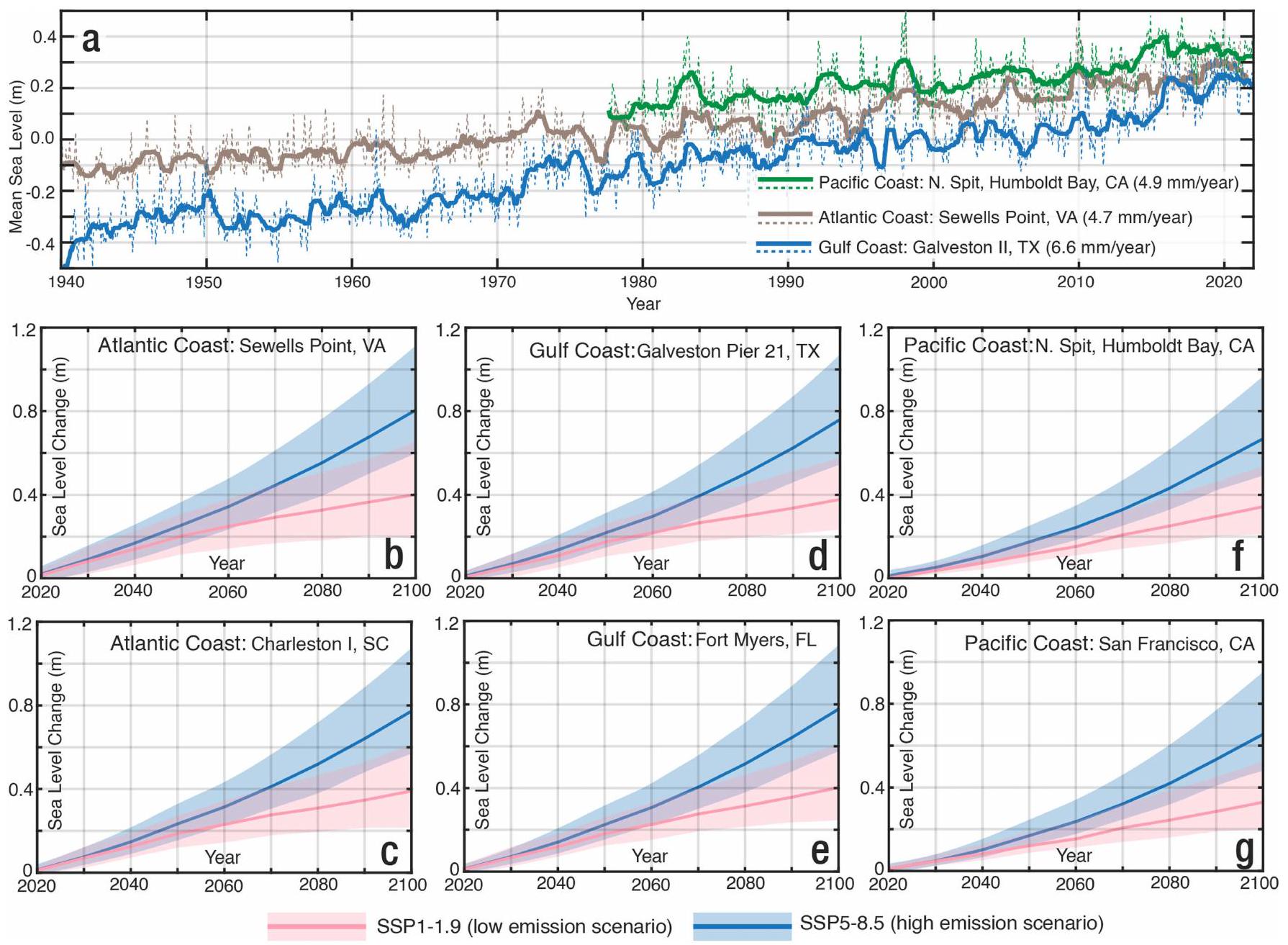
المثلثات الموضحة في الشكل 1أ. مقارنة بين سيناريوهات الانبعاثات المنخفضة (SSP1-1.9) وسيناريوهات الانبعاثات العالية (SSP5-8.5) (ثقة متوسطة) لساحل المحيط الأطلسي في نقطة سيويل، فيرجينيا (ب) وشارلستون I، ساوث كارولينا (ج)؛ ساحل الخليج في جالفستون رصيف 21، تكساس (د) وفورت مايرز، فلوريدا (هـ)؛ وساحل المحيط الهادئ في نورث سبايت، خليج هومبولت، كاليفورنيا (و) وسان فرانسيسكو،
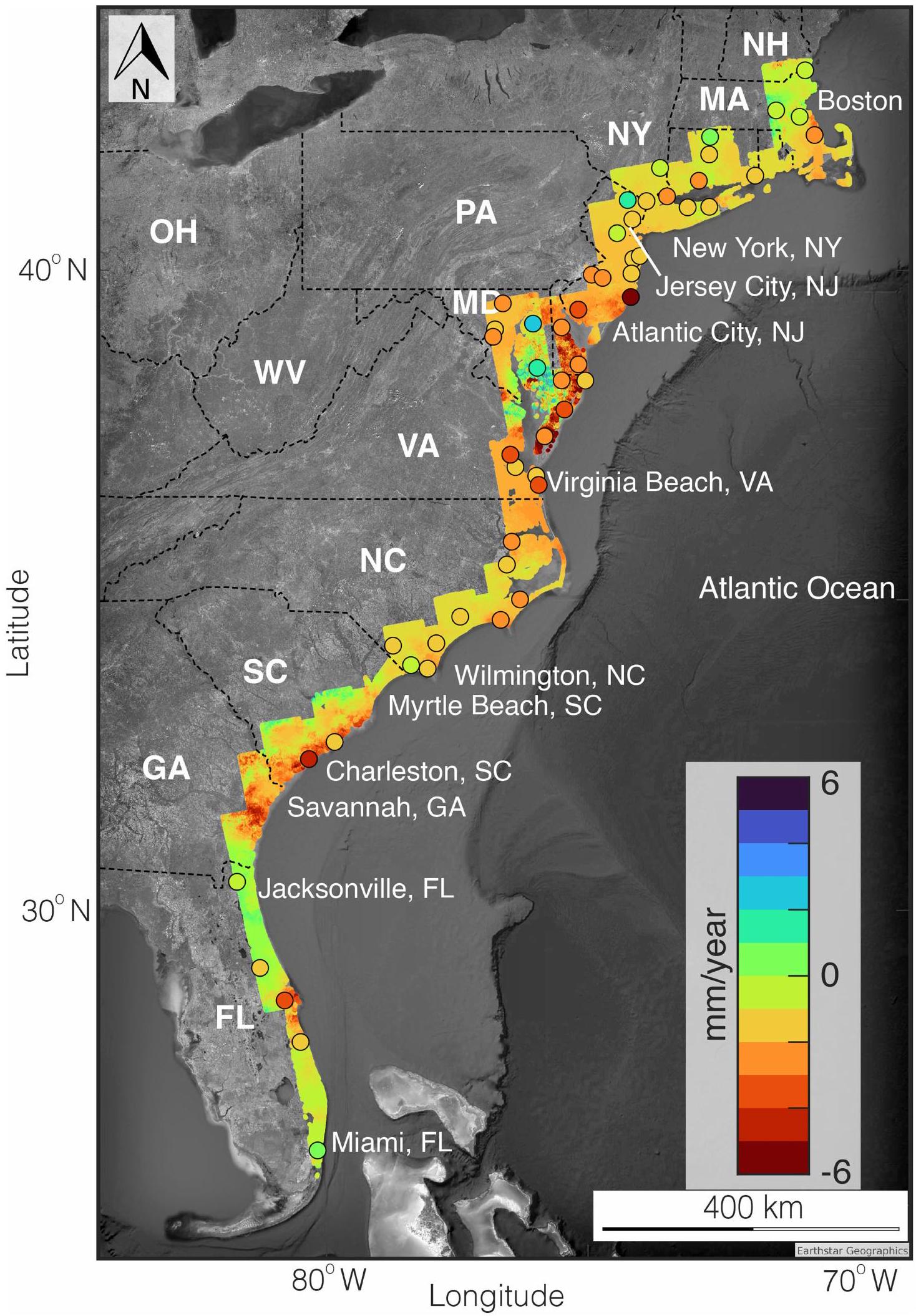
مع معدلات InSAR في الشكل التكميلي 11c. رموز الولايات: NH، نيوهامبشير؛ MA، ماساتشوستس؛ NY، نيويورك؛ PA، بنسلفانيا؛ NJ، نيوجيرسي؛ MD، ماريلاند؛ WV، فرجينيا الغربية؛ OH، أوهايو؛ VA، فرجينيا؛ NC، كارولينا الشمالية؛ SC، كارولينا الجنوبية؛ GA، جورجيا؛ FL، فلوريدا. حدود الولايات تعتمد على بيانات المتجهات العامة من بنك البيانات التابع للبنك الدولي (https://data. worldbank.org/) التي تم إنشاؤها في MATLAB.
المقال
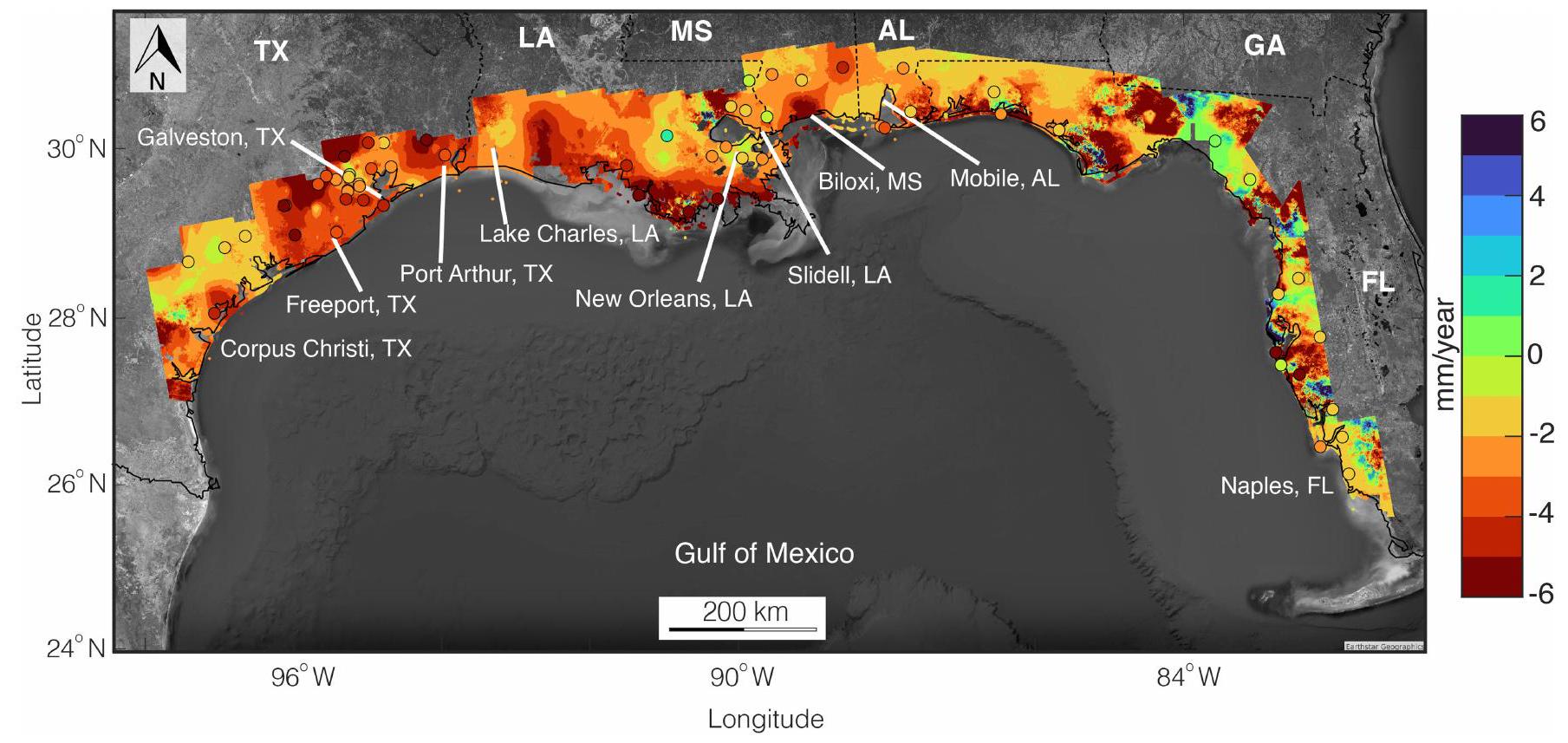
لمعدلات الرأسية من 157 محطة GNSS مع معدلات InSAR تظهر في الشكل التكميلي 11d. رموز الولايات: TX، تكساس؛ LA، لويزيانا؛ MS، ميسيسيبي؛ AL، ألاباما؛ GA، جورجيا؛ FL، فلوريدا. تعتمد الحدود الوطنية والولائية على بيانات المتجهات العامة من بنك البيانات التابع للبنك الدولي (https://data. worldbank.org/) التي تم إنشاؤها في MATLAB.
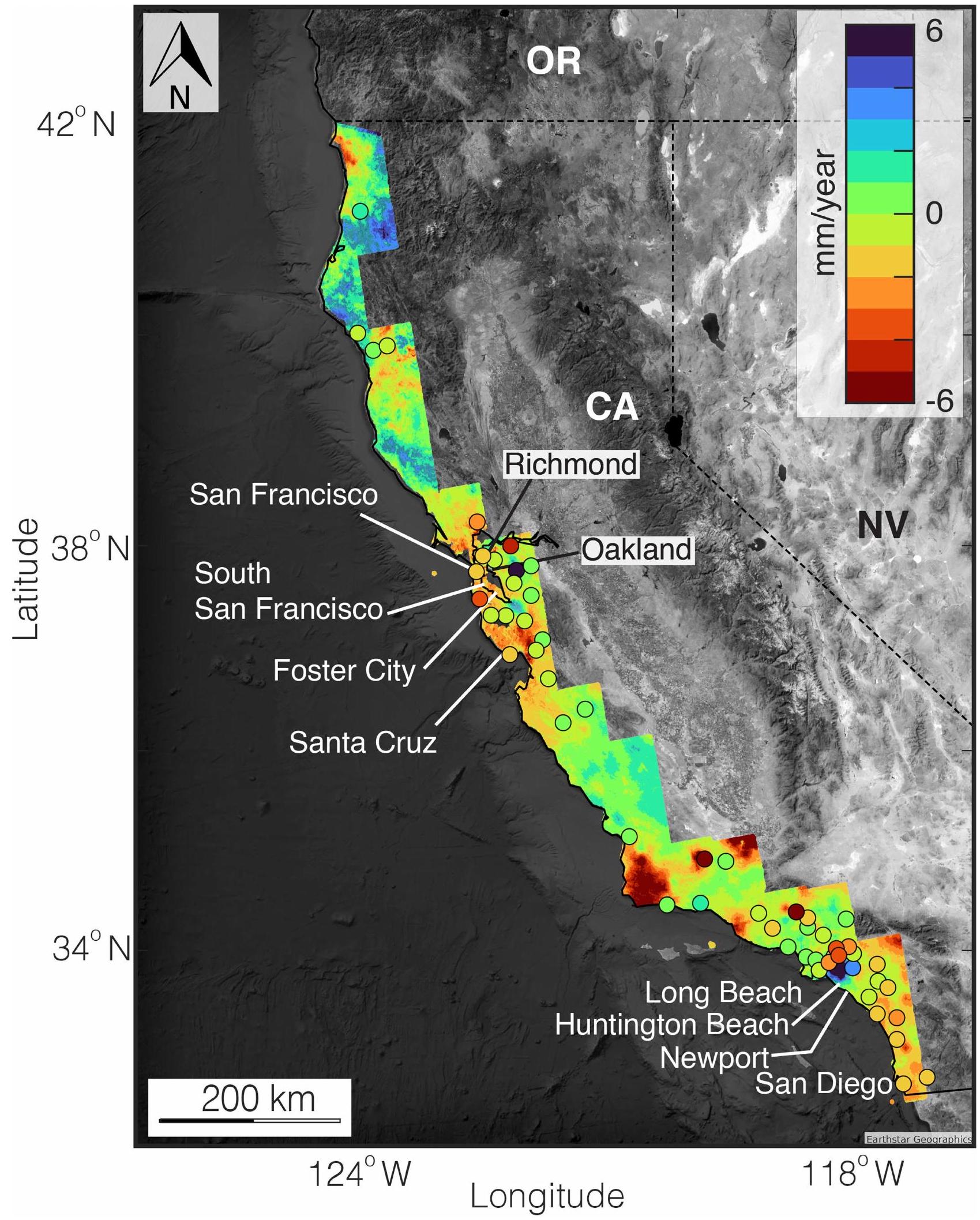
المقال
تشير معدلات مستوى سطح البحر الإيجابية إلى ارتفاع، بينما تشير المعدلات السلبية إلى هبوط. المدن الساحلية الهادئة العشر التي تم تقييمها في هذه الدراسة مميزة في الشكل. الصورة الخلفية من جوجل، إيرثستار. تُظهر السرعات الرأسية لمحطات التحقق من GNSS باستخدام دوائر ملونة على الخريطة. لاحظ أنه تم رسم مجموعة فرعية فقط من بيانات GNSS لتجنب الفوضى. تظهر المقارنة لمعدلات الرأسية من 381 محطة GNSS مع معدلات InSAR في الشكل التكميلي 11b. رموز الولايات: OR، أوريغون؛ CA، كاليفورنيا؛ NV، نيفادا. تعتمد الحدود الوطنية والولائية على بيانات المتجهات العامة من بنك البيانات التابع للبنك الدولي (https://data.worldbank.org/
) التي تم إنشاؤها في MATLAB.
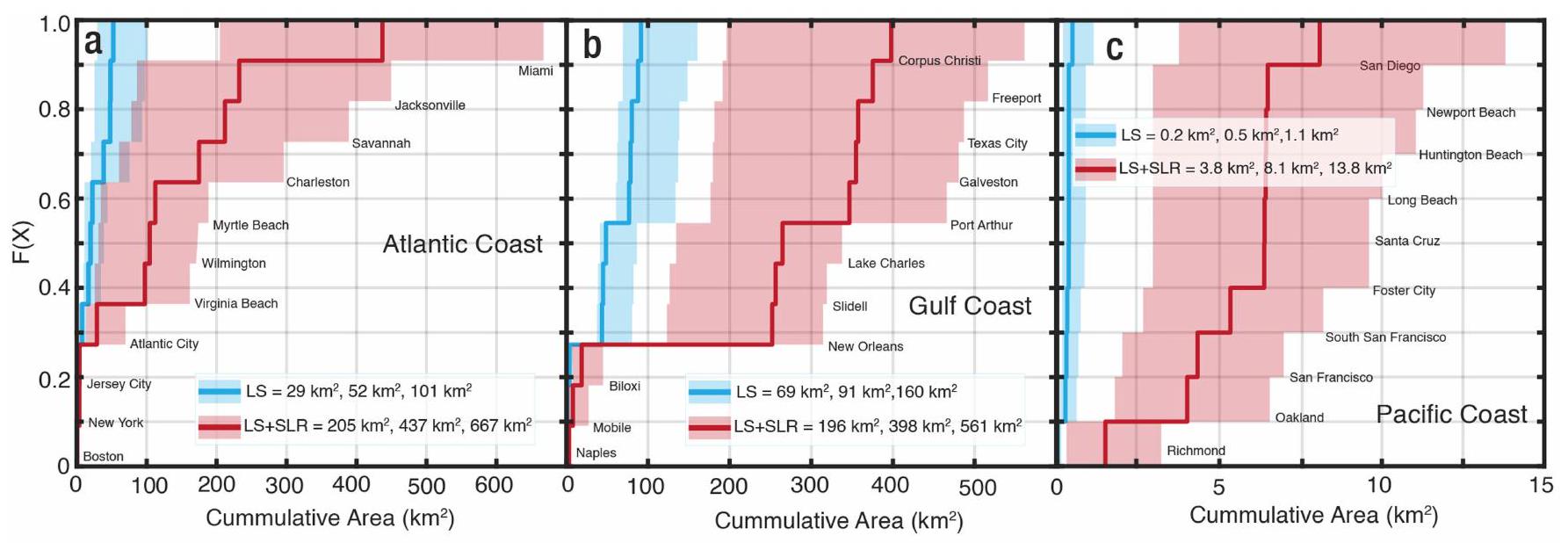

, مع التغير في مستوى البحر الناتج عن هبوط الأرض من قياسات InSAR في هذه الدراسة
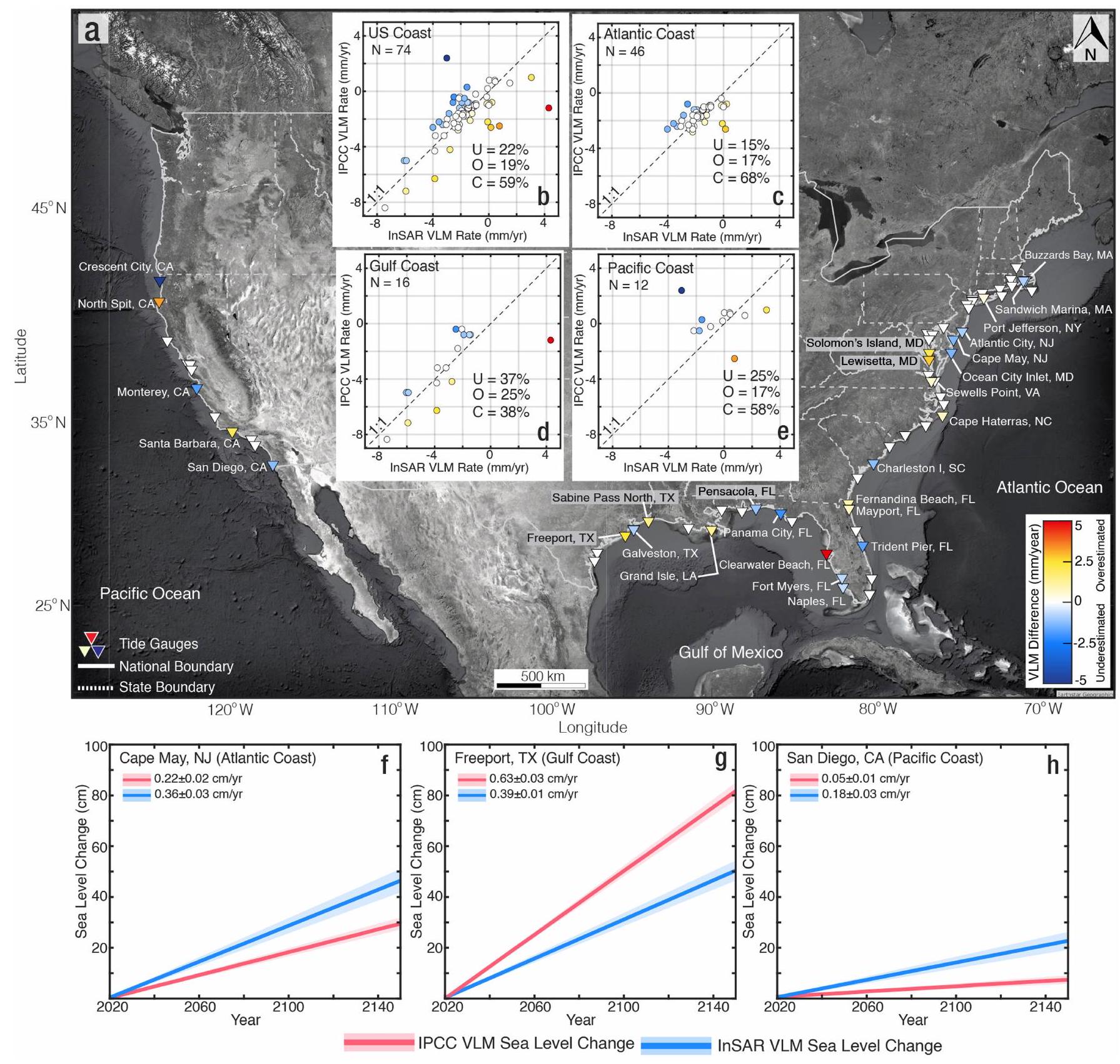
– في البداية لمقارنة معدلات مستوى البحر من كلا المصدرين. المحطات التي لم يُلاحظ فيها فرق إحصائي تم تمييزها باللون الأبيض، مما يدل على قيم مستوى البحر المتسقة (C). المحطات التي تكون فيها معدلات هبوط الأرض IPCC
– تم تفصيل الاختبار في الجدول التكميلي 12. المقارنة الإحصائية لمعدل مستوى البحر IPCC مقابل معدل مستوى البحر InSAR للساحل الأمريكي (ب)، الساحل الأطلسي (ج)، الساحل الخليجي (د) والساحل الهادئ (هـ). أمثلة على مقارنة مستوى البحر للساحل الأطلسي (كيب ماي، NJ) (و)، الساحل الخليجي (فريبورت، TX) (ز) والساحل الهادئ (سان دييغو، CA) (ح). رموز الولايات: MA، ماساتشوستس؛ NY، نيويورك؛ NJ، نيوجيرسي؛ MD، ماريلاند؛ VA، فرجينيا؛ NC، كارولينا الشمالية؛ SC، كارولينا الجنوبية؛ GA، جورجيا؛ FL، فلوريدا؛ TX، تكساس؛ LA، لويزيانا؛ CA، كاليفورنيا.
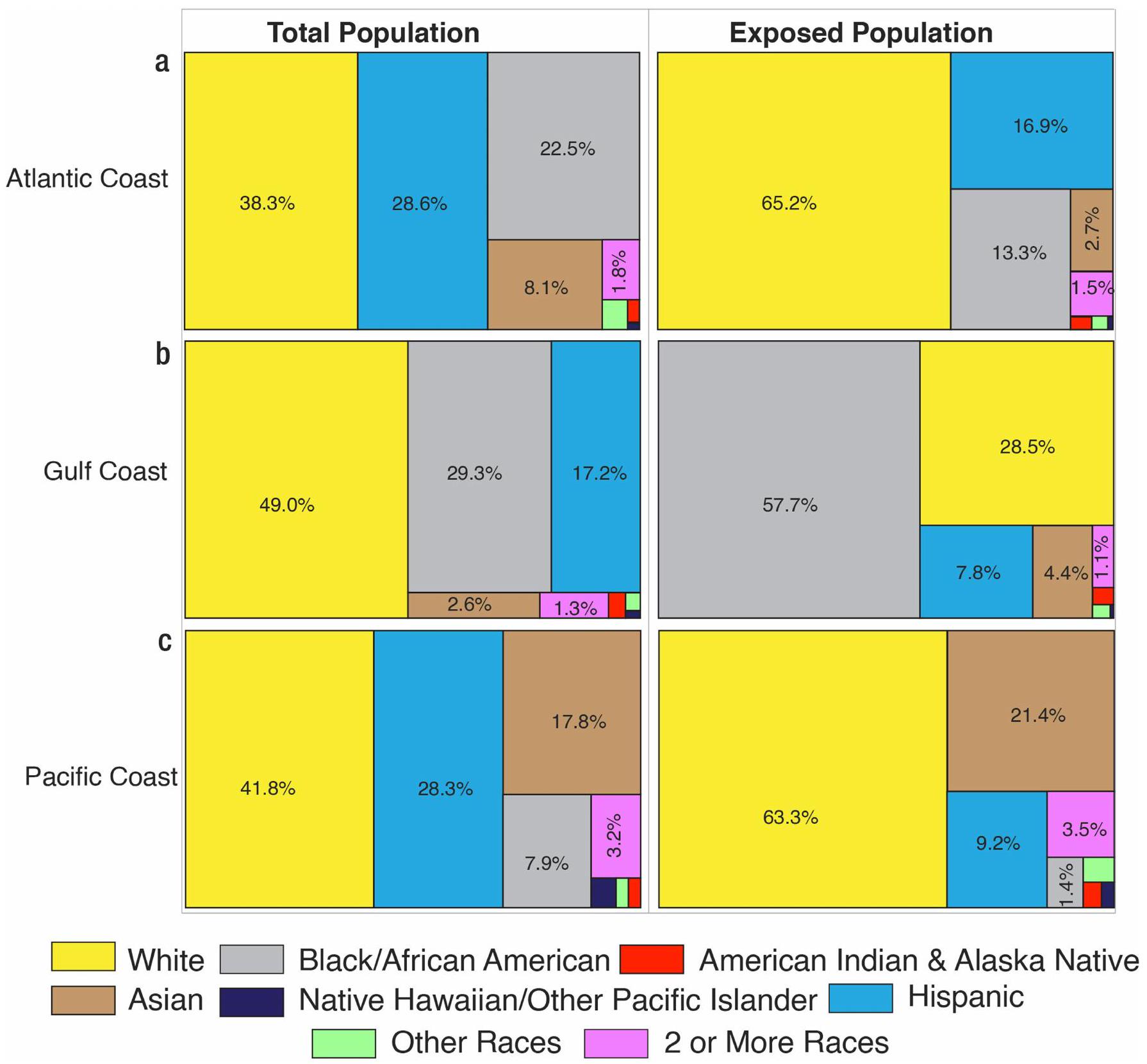
الشكل البياني الموسع 7 | إجمالي السكان مقابل السكان المعرضين بحلول عام 2050 لمختلف الفئات العرقية على الساحل الأمريكي. خريطة شجرية للسكان الإجماليين والمعرضين للساحل الأطلسي (أ)، الساحل الخليجي (ب) والساحل الهادئ (ج). يتم التعبير عن السكان الإجماليين والمعرضين كنسبة مئوية من إجمالي السكان للساحل. تمثل النسب المئوية للسكان المعرضين فقط القيم المتوسطة للتعرض التي تم تقييمها باستخدام
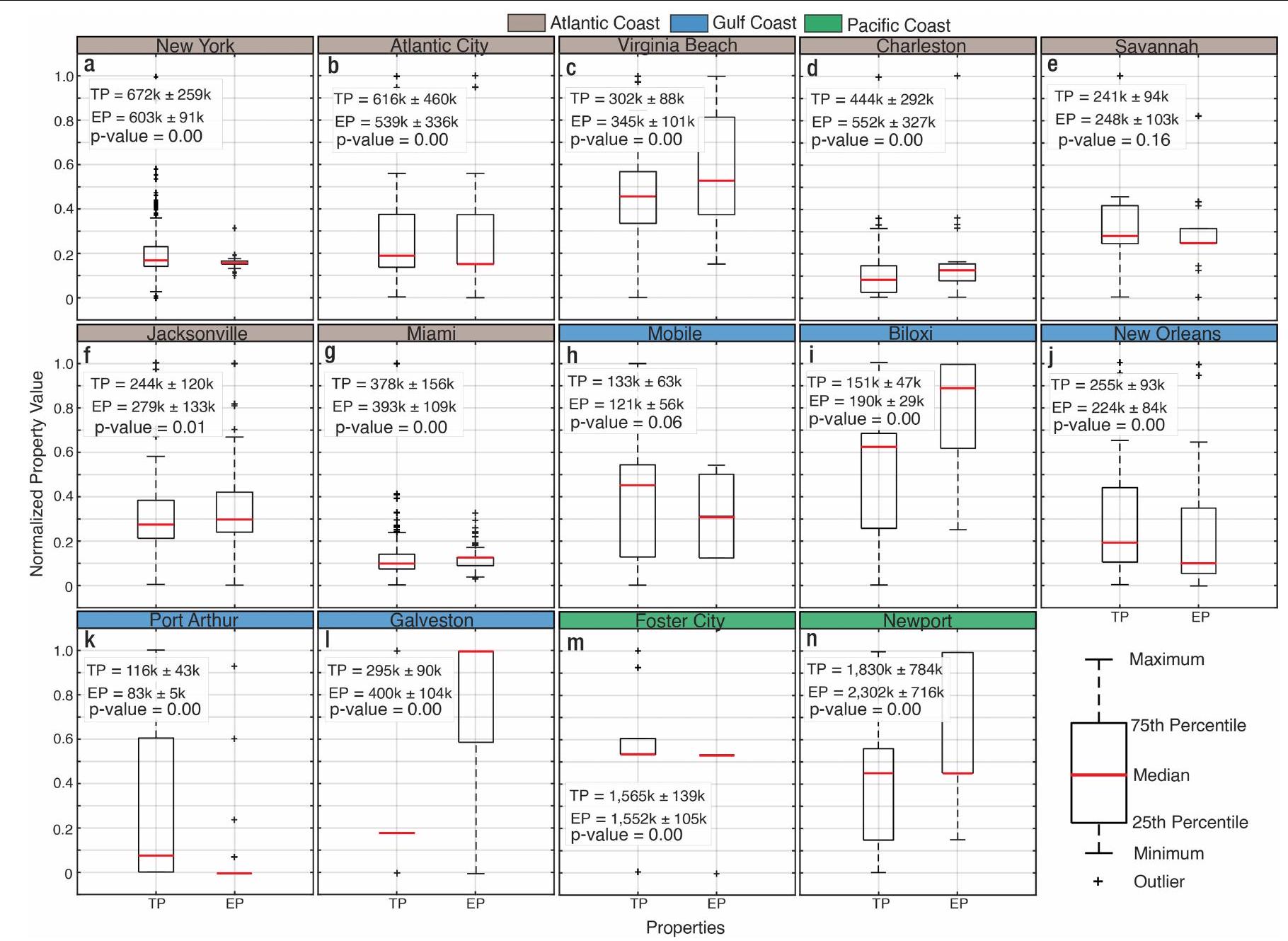
لـ TP و EP يُظهر القيم المعيارية. القيم لكل رسم تُظهر القيمة المتوسطة،
المقال
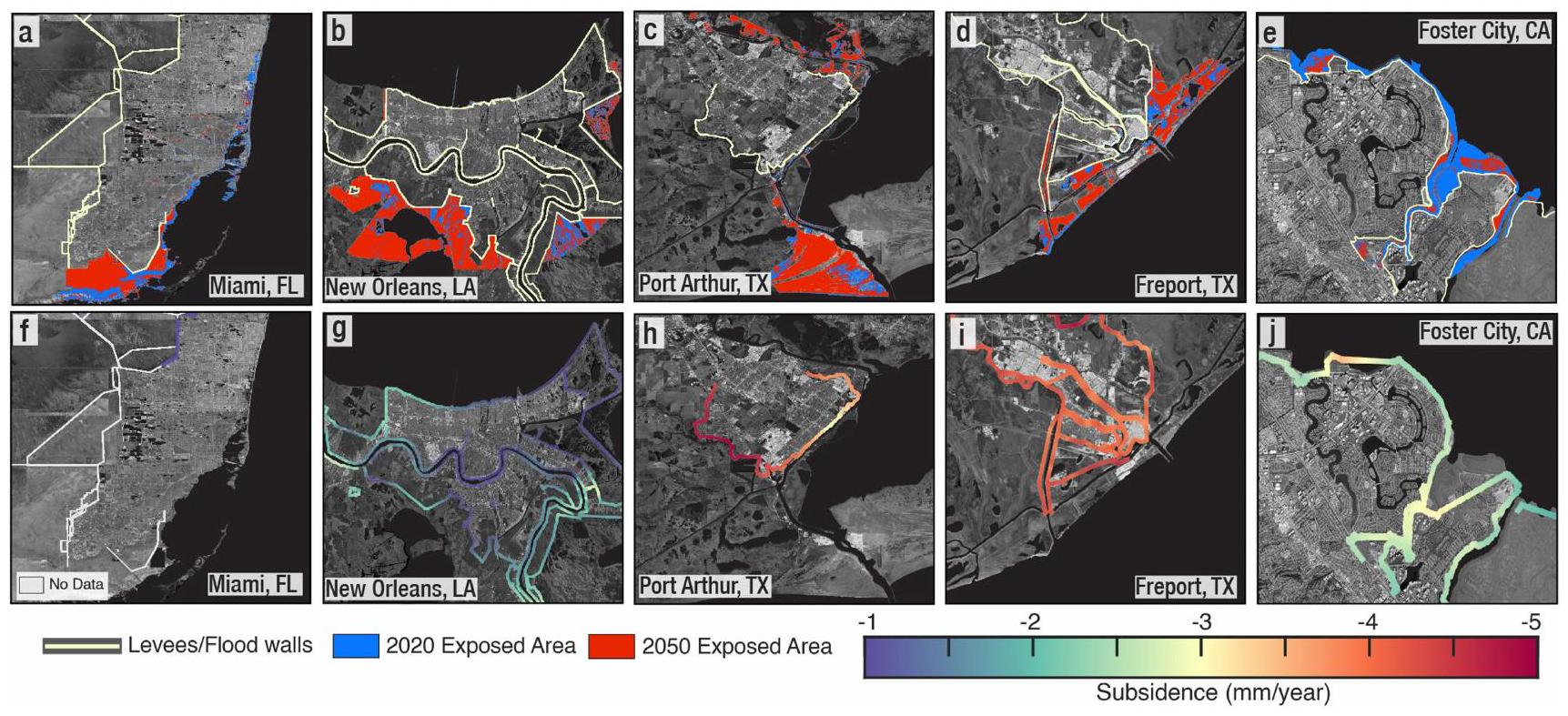
الهياكل في: ميامي، فلوريدا (ف); نيو أورلينز، لويزيانا (ج); بورت آرثر، تكساس (ح); فريبورت، تكساس (ي); فوستر سيتي،
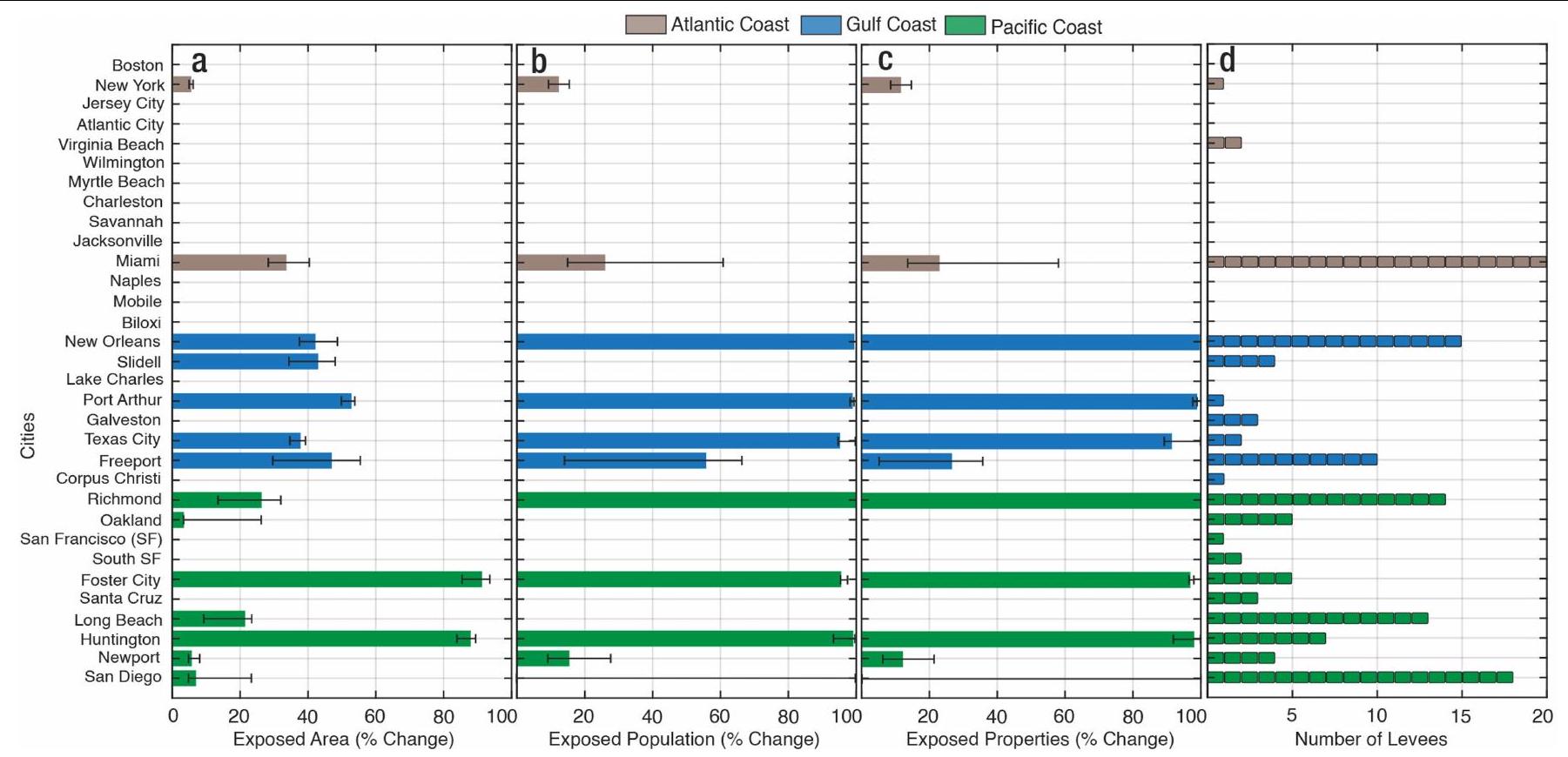
قسم علوم الأرض، جامعة فيرجينيا تك، بلاكسبرغ، فيرجينيا، الولايات المتحدة الأمريكية. معهد الأمن القومي بجامعة فيرجينيا تك، جامعة فيرجينيا تك، بلاكسبرغ، فيرجينيا، الولايات المتحدة الأمريكية. معهد المياه والبيئة والصحة، جامعة الأمم المتحدة، هاملتون، أونتاريو، كندا. قسم علوم الأرض والبيئة، معهد العلوم الأساسية في موهالي، بنجاب، الهند. قسم علوم الأرض والبيئة والعلوم الكوكبية، جامعة براون، بروفيدنس، رود آيلاند، الولايات المتحدة الأمريكية. المعهد في براون للبيئة والمجتمع، جامعة براون، بروفيدنس، رود آيلاند، الولايات المتحدة الأمريكية. مركز تيندال لأبحاث تغير المناخ، جامعة شرق أنجليا، نورويتش، المملكة المتحدة. البريد الإلكتروني: ohleonard@vt.edu
DOI: https://doi.org/10.1038/s41586-024-07038-3
PMID: https://pubmed.ncbi.nlm.nih.gov/38448695
Publication Date: 2024-03-06
Disappearing cities on US coasts
https://doi.org/10.1038/s41586-024-07038-3
Accepted: 5 January 2024
Published online: 6 March 2024
Open access
Check for updates
Abstract
The sea level along the US coastlines is projected to rise by
On the coasts of the conterminous USA, climate-induced sea levels are rising faster than the global average
Sea levels are projected to vary minimally in the next few decades across the different greenhouse gas emission scenarios, whereas end-of-century projections indicate a more substantial divergence in increase by emissions (Extended Data Fig. 1b-g). Thus, short-term vulnerability assessments incorporating local drivers are relevant to policymakers for developing comprehensive adaptation strategies that extend beyond emission reduction, as they provide insights into the immediate risks and challenges of coastal communities. However, accurately projecting coastal vulnerability requires comprehensive and high-resolution measurements of VLM, which is lacking across the USA at present

representing the distribution of VLM for 32 US coastal cities evaluated in this study. The 32 coastal cities evaluated in this study are highlighted in a. The cities include: US Atlantic coast:1. Boston, MA; 2. New York City, NY; 3.Jersey City, NJ; 4. Atlantic City, NJ; 5. Virginia Beach, VA; 6. Wilmington, NC; 7. Myrtle Beach, SC; 8. Charleston, SC; 9. Savannah, GA; 10. Jacksonville, FL; 11. Miami, FL; US Gulf coast: 12. Naples, FL; 13. Mobile, AL; 14. Biloxi, MS; 15. New Orleans, LA; 16. Slidell, LA;17. Lake Charles, LA;18. Port Arthur, TX;19. Texas City, TX;20. Galveston, TX; 21. Freeport, TX; 22. Corpus Christi, TX; US Pacific coast: 23. Richmond, CA;24. Oakland, CA;25. San Francisco, CA;26. South San Francisco, CA;27. Foster City, CA;28. Santa Cruz, CA;29. Long Beach, CA;30. Huntington Beach, CA; 31. Newport Beach, CA; 32. San Diego, CA.
population and properties of US coastal communities and explore several adaptation regimes to minimize potential future impacts.
Future socioeconomic impact of relative SLR on US coasts
changes, attributable to VLM and geocentric SLR, will increase the exposure-area, population and properties-to high-tide flooding by 2050 , using 2020 as the baseline (see Methods). For the analysis, we consider the SLR scenario derived from Shared Socioeconomic Pathway (SSP) scenario 2-4.5 (SSP2-4.5), representing the current emissions trajectory

with a total estimated home value of US$32-109 billion by 2050. The maximum population and property exposure by 2050 represents approximately 1 in 50 people and 1 in 35 properties from the 32 coastal cities.
Atlantic coast
Gulf coast
Gulf coast (year 2050: SSP2-4.5)

for current exposure, geocentric SLR
Pacific coast
Land subsidence is a critical driver of coastal hazards
areas below sea level resulting from a combination of land subsidence and sea-level change. Using linear projections of the current VLM rate and coastal-elevation data, we determine the land areas that, despite being above sea level at present, will be inundated by 2050 under both scenarios. Our analysis indicates that land areas below sea levels by 2050 resulting from only land subsidence account for

Climate-change inequalities
| Coast | InSAR-derived | IPCC-derived | ||||||
| 2050 further exposed area (
|
2050 further exposed population | 2050 further exposed properties | 2050 home-value exposure (US$ billion) | 2050 further exposed area (
|
2050 further exposed population | 2050 further exposed properties | ||
| Atlantic | a | 772.5 | 59,276 | 32,986 | 14.0 | 763.9 | 61,715 | 34,803 |
| b | 871.5 | 100,276 | 60,580 | 25.0 | 871.3 | 96,866 | 58,658 | |
| c | 951.1 | 262,926 | 163,533 | 64.0 | 952.6 | 242,139 | 151,597 | |
| Gulf | a | 536.7 | 110,647 | 58,423 | 14.0 | 663.3 | 203,896 | 99,421 |
| b | 669.7 | 159,776 | 78,609 | 16.0 | 797.6 | 252,320 | 122,039 | |
| c | 827.6 | 225,167 | 109,505 | 21.0 | 924.6 | 286,080 | 142,089 | |
| Pacific | a | 19.8 | 6,478 | 3,038 | 4.5 | 16.4 | 9,989 | 4,547 |
| b | 29.0 | 12,180 | 5,707 | 9.3 | 28.2 | 13,433 | 6,301 | |
| c | 40.2 | 30,798 | 15,110 | 22.0 | 32.3 | 21,034 | 10,749 | |
| Total | a | 1,329.0 | 176,401 | 94,447 | 32.5 | 1,443.6 | 275,600 | 138,771 |
| b | 1,570.2 | 272,232 | 144,896 | 50.3 | 1,697.1 | 362,619 | 186,998 | |
| c | 1,818.9 | 518,891 | 288,148 | 107.0 | 1,909.5 | 549,253 | 304,435 | |
 exposure for each city.
exposure for each city.are out of reach
Towards sustainable adaptation strategies

values indicate cities in which IPCC-derived VLM exposure is overestimated, whereas positive values indicate areas in which exposure is underestimated. d, Comparison of InSAR versus IPCC VLM rates for the 32 cities. The InSAR VLM rates are obtained by averaging the VLM for each city used in the exposure analysis, whereas the IPCC VLM rates are derived from tide-gauge stations. The error ranges for the InSAR and IPCC VLM show
manifest? Here we will consider the proactive option. Adaptation is a long-term process and some combination of strategies is probably most appropriate sequenced following an adaptive-pathways approach
Artificial coastal-defence structures, such as levees, berms, dykes and floodwalls, protect coastal communities by decreasing the consequences of flooding and inundation in exposed areas
limited flood protection. Nevertheless, most existing structure-based coastal-defence systems were not designed with climate change in mind, and large upgrades may be required to remain effective even to 2050 (ref. 45). This is most relevant where subsidence and differential subsidence affect the use of flood-control structures by lowering their effective height below inundation depths and promoting structural failure
driven by anthropogenic influences and within reach with concerted societal efforts at all levels (policymakers to citizens).
Online content
- Haer, T., Kalnay, E., Kearney, M. & Moll, H. Relative sea-level rise and the conterminous United States: consequences of potential land inundation in terms of population at risk and GDP loss. Glob. Environ. Change 23, 1627-1636 (2013).
- Shirzaei, M. & Bürgmann, R. Global climate change and local land subsidence exacerbate inundation risk to the San Francisco Bay Area. Sci. Adv. 4, eaap9234 (2018).
- Sweet, W. V. et al. Global and Regional Sea Level Rise Scenarios for the United States: Updated Mean Projections and Extreme Water Level Probabilities along U.S. Coastlines. NOAA Technical Report NOS 01. (National Oceanic and Atmospheric Administration, 2022).
- Dinar, A. et al. We lose ground: global assessment of land subsidence impact extent. Sci. Total Environ. 786, 147415 (2021).
- Ingebritsen, S. E. & Galloway, D. L. Coastal subsidence and relative sea level rise. Environ. Res. Lett. 9, 091002 (2014).
- Woodruff, J., Irish, J. & Camargo, S. Coastal flooding by tropical cyclones and sea-level rise. Nature 504, 44-52 (2013).
- Kossin, J. P., Knapp, K. R., Olander, T. L. & Velden, C. S. Global increase in major tropical cyclone exceedance probability over the past four decades. Proc. Natl Acad. Sci. USA 117, 11975-11980 (2020).
- Chiang, F., Mazdiyasni, O. & AghaKouchak, A. Evidence of anthropogenic impacts on global drought frequency, duration, and intensity. Nat. Commun. 12, 2754 (2021).
- Intergovernmental Panel on Climate Change (IPCC). Climate Change 2022: Impacts, Adaptation and Vulnerability. Contribution of Working Group II to the Sixth Assessment Report of the Intergovernmental Panel on Climate Change (eds Pörtner, H.-O. et al.) (Cambridge Univ. Press, 2022).
- McGranahan, G., Balk, D. & Anderson, B. The rising tide: assessing the risks of climate change and human settlements in low elevation coastal zones. Environ. Urban. 19, 17-37 (2007).
- Nicholls, R. J. & Cazenave, A. Sea-level rise and its impact on coastal zones. Science 328, 1517-1520 (2010).
- Aerts, J. C. J. H. et al. Evaluating flood resilience strategies for coastal megacities. Science 344, 473-475 (2014).
- Neumann, B., Vafeidis, A. T., Zimmermann, J. & Nicholls, R. J. Future coastal population growth and exposure to sea-level rise and coastal flooding – a global assessment. PLoS ONE 10, e0118571 (2015).
- Hauer, M. E. et al. Sea-level rise and human migration. Nat. Rev. Earth Environ. 1, 28-39 (2020).
- Church, J. A. & White, N. J. Sea-level rise from the late 19th to the early 21st century. Surv. Geophys. 32, 585-602 (2011).
- Sweet, W. V. & Park, J. From the extreme to the mean: acceleration and tipping points of coastal inundation from sea level rise. Earths Future 2, 579-600 (2014).
- Fox-Kemper, B. et al. in Climate Change 2021: The Physical Science Basis. Contribution of Working Group I to the Sixth Assessment Report of the Intergovernmental Panel on Climate Change (eds Masson-Delmotte, V. et al.) Ch. 9 (Cambridge Univ. Press, 2021).
- Nicholls, R. J. et al. Stabilization of global temperature at
and : implications for coastal areas. Philos. Trans. A Math. Phys. Eng. Sci. 376, 20160448 (2018). - Nicholls, R. J. et al. A global analysis of subsidence, relative sea-level change and coastal flood exposure. Nat. Clim. Change 11, 338-342 (2021).
- Sherpa, S. F., Shirzaei, M. & Ojha, C. Disruptive role of vertical land motion in future assessments of climate change-driven sea-level rise and coastal flooding hazards in the Chesapeake Bay. J. Geophys. Res. Solid Earth 128, e2022JB025993 (2023).
- Thatcher, C. A., Brock, J. C. & Pendleton, E. A. Economic vulnerability to sea-level rise along the Northern U.S. Gulf coast. J. Coast. Res. 63, 234-243 (2013).
- Marsooli, R., Lin, N., Emanuel, K. & Feng, K. Climate change exacerbates hurricane flood hazards along US Atlantic and Gulf Coasts in spatially varying patterns. Nat. Commun. 10, 3785 (2019).
- Fast Facts: Economics and Demographics. NOAA Office for Coastal Management https:// coast.noaa.gov/states/fast-facts/economics-and-demographics.html (2022).
- Hsiang, S. et al. Estimating economic damage from climate change in the United States. Science 356, 1362-1369 (2017).
- Ezer, T. & Atkinson, L. P. Accelerated flooding along the US East Coast: on the impact of sea-level rise, tides, storms, the Gulf Stream, and the North Atlantic Oscillations. Earths Future 2, 362-382 (2014).
- Vitousek, S. et al. Doubling of coastal flooding frequency within decades due to sea-level rise. Sci. Rep. 7, 1399 (2017).
- Blackwell, E., Shirzaei, M., Ojha, C. & Werth, S. Tracking California’s sinking coast from space: implications for relative sea-level rise. Sci. Adv. 6, eaba4551 (2020).
- Ohenhen, L. O., Shirzaei, M., Ohja, C. & Kirwan, M. Hidden vulnerability of US Atlantic coast to sea-level rise due to vertical land motion. Nat. Commun. 14, 2038 (2023).
- Sills, G. L. et al. Overview of New Orleans levee failures: lessons learned and their impact on national levee design and assessment. J. Geotech. Geoenviron. Eng. 134, 556-565 (2008).
- Sweet, W. V. et al. Patterns and Projections of High Tide Flooding along the U.S. Coastline Using a Common Impact Threshold. NOAA Technical Report NOS CO-OPS O86 (National Oceanic and Atmospheric Administration, 2018).
- Shadrick, J. R. et al. Sea-level rise will likely accelerate rock coast cliff retreat rates. Nat. Commun. 13, 7005 (2022).
- Herrera-García, G. et al. Mapping the global threat of land subsidence. Science 371, 34-36 (2021).
- Candela, T. & Koster, K. The many faces of anthropogenic subsidence. Science 376, 1381-1382 (2022).
- Garner, G. G. et al. IPCC AR6 Sea-Level Rise Projections. https://podaac.jpl.nasa.gov/ announcements/2021-08-09-Sea-level-projections-from-the-IPCC-6th-AssessmentReport (2021).
- Islam, S. N. & Winkel, J. Climate Change and Social Inequality. Working Paper No. 152 (United Nations Department of Economic and Social Affairs, 2017).
- Brouwer, R., Akter, S., Brander, L. & Haque, E. Socioeconomic vulnerability and adaptation to environmental risk: a case study of climate change and flooding in Bangladesh. Risk Anal. 27, 313-326 (2007).
- Rentschler, J., Salhab, M. & Jafino, B. A. Flood exposure and poverty in 188 countries. Nat. Commun. 13, 3527 (2022).
- United States Environmental Protection Agency. Climate Change and Social Vulnerability in the United States: A Focus on Six Impacts. EPA 430-R-21-003. www.epa.gov/cira/ social-vulnerability-report (2021).
- Brown, D. L. On Mississippi’s Gulf Coast, what was lost and gained from Katrina’s fury. Washington Post https://www.washingtonpost.com/local/on-mississippis-gulf-coast-what-was-lost-and-gained-from-katrinas-fury/2015/08/26/2c00956a-4313-11e5-846d02792f854297_story.html (26 August 2015).
- Hauer, M. E. et al. Assessing population exposure to coastal flooding due to sea level rise. Nat. Commun. 12, 6900 (2021).
- Haasnoot, M. et al. Generic adaptation pathways for coastal archetypes under uncertain sea-level rise. Environ. Res. Commun. 1, 071006 (2019).
- Nicholls, R. J. et al. Ranking Port Cities with High Exposure and Vulnerability to Climate Extremes: Exposure Estimates. OECD Environment Working Papers, No. 1 (OECD Publishing, 2008).
- Hallegatte, S. et al. Future flood losses in major coastal cities. Nat. Clim. Change 3, 802-806 (2013).
- Sung, K., Jeong, H., Sangwan, N. & Yu, D. J. Effects of flood control strategies on flood resilience under sociohydrological disturbances. Water Resour. Res. 54, 2661-2680 (2018).
- Duarte, C. M., Losada, I. J., Hendriks, I. E., Mazarrasa, I. & Marbà, N. The role of coastal plant communities for climate change mitigation and adaptation. Nat. Clim. Change 3, 961-968 (2013).
- Dixon, T. et al. Space geodesy: subsidence and flooding in New Orleans. Nature 441, 587-588 (2006).
- Zoysa, R. S. et al. The ‘wickedness’ of governing land subsidence: policy perspectives from urban southeast Asia. PLoS ONE 16, e0250208 (2021).
- Shirzaei, M. et al. Measuring, modelling and projecting coastal land subsidence. Nat. Rev. Earth Environ. 2, 40-58 (2021).
- Fang, J. et al. Benefits of subsidence control for coastal flooding in China. Nat. Commun. 13, 6946 (2022).
- Cozannet, G. L. et al. Adaptation to multi-meter sea-level rise should start now. Environ. Res. Lett. 18, 091001 (2023).
© The Author(s) 2024, corrected publication 2024
Methods
VLM data
coasts are shown in Supplementary Fig. 5a. The spatial distribution of the standard deviation shows that most values are below 3 mm per year for the US Atlantic and Gulf coasts. However, there are a few hotspots of high standard deviation around the Chesapeake Bay area (US Atlantic coast) and around the coast of Florida (US Gulf coast). We note higher estimated standard deviation values in the US Pacific coast, specifically in Northern California and the Orange County basin
assess the non-GIA contributions to the estimated VLM along US coasts (Supplementary Fig. 2). The relative reduction of subsidence by
Coastal cities selection and elevation data
Population, properties and racial demographic data
Sea-level projections
High-tide estimates
Inundation model
-
or grid LiDAR DEM for each city. - About
resolution VLM data for each city. - MHW levels at tide gauges adjacent to each city (Supplementary Table 24).
- IPCC geocentric SLR projections at the stations adjacent to each city (Supplementary Table 24).
Socioeconomic exposure analysis
Subsidence hazard exposure analysis for levees
Data availability
Code availability
51. Miller, M. M. & Shirzaei, M. Assessment of future flood hazards for southeastern Texas: synthesizing subsidence, sea-level rise, and storm surge scenarios. Geophys. Res. Lett. 48, e2021GL092544 (2021).
52. Barnard, P. L. et al. Future Coastal Hazards Along the U.S. North and South Carolina Coasts. US Geological Survey data release. https://doi.org/10.5066/P9W91314 (2023).
53. Barnard, P. L. et al. Future Coastal Hazards Along the U.S. Atlantic Coast. US Geological Survey data release. https://doi.org/10.5066/P9BQQTCI (2023).
54. Wegnüller, U. et al. Sentinel-1 support in the GAMMA software. Proc. Comput. Sci. 100, 1305-1312 (2016).
55. Werner, C., Wegmüller, U., Strozzi, T., & Wiesmann, A. Gamma SAR and interferometric processing software. ERS – Envisat Symposium (2000).
56. Shirzaei, M. & Bürgmann, R. Topography correlated atmospheric delay correction in radar interferometry using wavelet transforms. Geophys. Res. Lett. 39, L01305 (2012).
57. Shirzaei, M. A wavelet-based multitemporal DInSAR algorithm for monitoring ground surface motion. IEEE Geosci. Remote Sens. Lett. 10, 456-460 (2013).
58. Shirzaei, M., Bürgmann, R. & Fielding, E. J. Applicability of Sentinel-1 terrain observation by progressive scans multitemporal interferometry for monitoring slow ground motions in the San Francisco Bay Area. Geophys. Res. Lett. 44, 2733-2742 (2017).
59. Shirzaei, M., Manga, M. & Zhai, G. Hydraulic properties of injection formations constrained by surface deformation. Earth Planet. Sci. Lett. 515, 125-134 (2019).
60. Lee, J.-C. & Shirzaei, M. Novel algorithms for pair and pixel selection and atmospheric error correction in multitemporal InSAR. Remote Sens. Environ. 286, 113447 (2023).
61. Ojha, C., Shirzaei, M., Werth, S., Argus, D. F. & Farr, T. G. Sustained groundwater loss in California’s Central Valley exacerbated by intense drought periods. Water Resour. Res. 54, 4449-4460 (2018).
62. Blewitt, G., Hammond, W. C. & Kreemer, C. Harnessing the GPS data explosion for interdisciplinary science. Eos 99, EO104623 (2018).
63. Allison, M. et al. Global risks and research priorities for coastal subsidence. Eos 97, 1-14 (2016).
64. Karegar, M. A., Dixon, T. H., Malservisi, R., Kusche, J. & Engelhart, S. E. Nuisance flooding and relative sea-level rise: the importance of present-day land motion. Sci. Rep. 7, 11197 (2017).
65. Kondolf, G. M. et al. Save the Mekong Delta from drowning. Science 376, 583-585 (2022).
66. Karegar, M. A., Dixon, T. H. & Engelhart, S. E. Subsidence along the Atlantic Coast of North America: insights from GPS and late Holocene relative sea level data. Geophys. Res. Lett. 43, 3126-3133 (2016).
67. Morton, R., Buster, N. A. & Krohn, M. Subsurface controls on historical subsidence rates and associated wetland loss in southcentral Louisiana. Gulf Coast Assoc. Geol. Soc. Trans. 52, 767-778 (2002).
68. Kolker, A. S., Allison, M. A. & Hameed, S. An evaluation of subsidence rates and sea-level variability in the northern Gulf of Mexico. Geophys. Res. Lett. 38, L21404 (2011).
69. Jones, C. E. et al. Anthropogenic and geologic influences on subsidence in the vicinity of New Orleans, Louisiana. J. Geophys. Res. Solid Earth 121, 3867-3887 (2016).
70. Peltier, W. R., Argus, D. F. & Drummond, R. Comment on “An Assessment of the ICE-6G_C (VM5a) Glacial Isostatic Adjustment Model” by Purcell et al. J. Geophys. Res. Solid Earth 123, 2019-2028 (2018).
71. Digital Coast: Data Access Viewer. NOAA. https://coast.noaa.gov/dataviewer/#/lidar/ search/ (2022).
72. Tide and Current Datums data sets. NOAA. https://tidesandcurrents.noaa.gov/stations. html?type=Datums (2022). Accessed [2022-08-04].
73. Hinkel, J., Nicholls, R. J., Vafeidis, A. T., Tol, R. S. J. & Avagianou, T. Assessing risk of and adaptation to sea-level rise in the European Union: an application of DIVA. Mitig. Adapt. Strateg. Glob. Chang. 15, 703-719 (2010).
74. Ramirez, J. A., Lichter, M., Coulthard, T. J. & Skinner, C. Hyper-resolution mapping of regional storm surge and tide flooding: comparison of static and dynamic models. Nat. Hazards 82, 571-590 (2016).
75. Vernimmen, R. & Hooijer, A. New lidar-based elevation model shows greatest increase in global coastal exposure to flooding to be caused by early-stage sea-level rise. Earths Future 11, e2022EF002880 (2023).
76. United States Army Corps of Engineers. National Levee Database. https://levees.sec. usace.army.mil/#/ (2022).
Additional information
Correspondence and requests for materials should be addressed to Leonard O. Ohenhen. Peer review information Nature thanks Robert Kopp and the other, anonymous, reviewer(s) for their contribution to the peer review of this work. Peer reviewer reports are available.
Reprints and permissions information is available at http://www.nature.com/reprints.
Article

triangles shown in Fig. 1a. Comparison of low-emission scenarios (SSP1-1.9) with high-emission scenarios (SSP5-8.5) (medium confidence) for the Atlantic coast Sewell’s Point, VA (b) and Charleston I, SC (c); Gulf coast Galveston Pier 21, TX (d) and Fort Myers, FL (e); and Pacific coast North Spit, Humboldt Bay, CA (f) and San Francisco,

with InSAR rates is shown in Supplementary Fig. 11c. State codes: NH, New Hampshire; MA, Massachusetts; NY, New York; PA, Pennsylvania; NJ, New Jersey; MD, Maryland; WV, West Virginia; OH, Ohio; VA, Virginia; NC, North Carolina; SC, South Carolina; GA, Georgia; FL, Florida. State boundaries are based on public-domain vector data by the World Bank DataBank (https://data. worldbank.org/) generated in MATLAB.
Article

of vertical rates from 157 GNSS stations with InSAR rates is shown in Supplementary Fig. 11d. State codes: TX, Texas; LA, Louisiana; MS, Mississippi; AL, Alabama; GA, Georgia; FL, Florida. National and state boundaries are based on public-domain vector data by the World Bank DataBank (https://data. worldbank.org/) generated in MATLAB.

Extended Data Fig. 4 | Spatial distribution of VLM across the US Pacific
prevent cluttering. The comparison of vertical rates from 381 GNSS stations with InSAR rates is shown in Supplementary Fig. 11b. State codes: OR, Oregon; CA, California; NV, Nevada. National and state boundaries are based on publicdomain vector data by the World Bank DataBank (https://data.worldbank.org/) generated in MATLAB.
Article


at three tide-gauge stations on the Gulf coast: Galveston Pier 21, TX (d); Eugene Island, LA (e); and Grand Isle, LA (f). The solid red line shows the median (50th percentile) IPCC sea-level change under SSP1-1.9 (low-emission scenario), whereas the red shaded range shows the 17th-83rd percentile. The solid brown line shows the median (50th percentile) IPCC sea-level change under SSP5-8.5 (high-emission scenario), whereas the brown shaded range shows the 17th-83rd percentile. The solid blue line shows the InSAR VLM from this study and the blue shaded ranges are one standard deviation. The black point and dashed line indicate when other processes exceed sea-level change from land subsidence. An example comparison for 20 tide-gauge stations across the US subsidence is shown in Supplementary Fig.1.

(negative VLM) are higher than the InSAR estimates are marked in yellow or red, indicating overestimation (O), whereas stations in which the IPCC subsidence rates are lower are marked in blue, indicating underestimation(U). Note that only stations with U or O are labelled in a. Summary of the VLM rates from IPCC and InSAR measurements and the
Article

equation (3). See Supplementary Tables 13-15 for the population of each city, including the lower and upper bounds. Minoritized groups include individuals identifying as Black or African American, American Indian or Alaska Native, Asian, Native Hawaiian or Other Pacific Islander, Hispanic or Latino, other races and two or more groups.

standard deviation and
Article

structures in: Miami, FL (f); New Orleans, LA (g); Port Arthur, TX (h); Freeport, TX(i);Foster City,

Department of Geosciences, Virginia Tech, Blacksburg, VA, USA. Virginia Tech National Security Institute, Virginia Tech, Blacksburg, VA, USA. Institute for Water, Environment and Health, United Nations University, Hamilton, Ontario, Canada. Department of Earth and Environmental Sciences, IISER Mohali, Punjab, India. Department of Earth, Environmental and Planetary Sciences, Brown University, Providence, RI, USA. Institute at Brown for Environment and Society, Brown University, Providence, RI, USA. Tyndall Centre for Climate Change Research, University of East Anglia, Norwich, UK. e-mail: ohleonard@vt.edu
